#inspired by gilgamesh from the final fantasy series
Explore tagged Tumblr posts
Text
Recapping The [REDACTED]’s Plan
(Not to be confused with [REDACTED] the collaborator. At least, I assume so)
If you’ve seen my previous SoP related posts, you’ll know that I’ve gone through this before, but this is more of a step by step walkthrough of sorts.
*Spoilers for Stranger of Paradise's DLC, as well as the Dissidia series in general*.
Part 1: The Plan
Stranger of Paradise’s DLC has a meta plot regarding the machinations of a certain newborn spirit. The DLC in general has more explicit ties to another game: Dissidia Final Fantasy. While the first DLC did not offer much, the second involved Gilgamesh, who also knew of a ‘Garland’ and brings up the possibility that said ‘Garland’ was a future version of Jack, although he wasn’t entirely sure if that was the case. The third DLC features the Emperor from Final Fantasy II who is actually coming from the world of those games. However, there are other nods up to and including the title (DiFFereNT Future). And then there is the Moogle.
As revealed in the missives, the Moogle hails from the World of Conflict as seen in Dissidia. A quick recap: the World of Conflict (hereafter referred to as “World B”) was a destroyed wasteland version of the FF1 world circa the first Dissidia. Shinryu was resting there when “The State” stumbled upon it and were promptly wrecked by it. The land also contained a crystal ore that seemed to be alive. “The State” experimented on this ore and created manikins: Living crystal which took the shape of the people who approached it (more on that in a bit).
When Chaos roars out of anger at his mom being shot, he creates a space-time phenomenon that destroys the lab and sends himself, Cid and Cosmos to World B. Garland is also here, for reasons unexplained though vaguely implied to be due to the lab where this took place being the (future?) site of the Chaos Shrine. With Shinryu also nearby (more on him in a bit), the 5 entered a pact to power Chaos up enough to escape.
In the end, however, it was not meant to be. Cosmos, inspired by her pawns, sought to break the cycle, arranging for her and Chaos’ deaths. With Chaos dead, even after Cosmos returned to life, the world was unbalanced and would sink into the Void.
But then, it didn’t.
Instead, the world was reborn with two new gods, born from the will of the old. This would be the setting of Dissidia arcade, with the two gods waging war on each other in the struggle of the gods: Not only because of their tensions, but because the world itself now relied on the energy sparked from such conflict to maintain its existence.
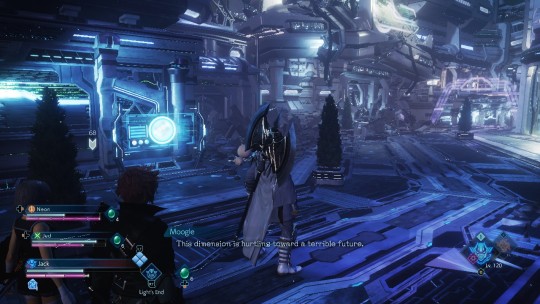
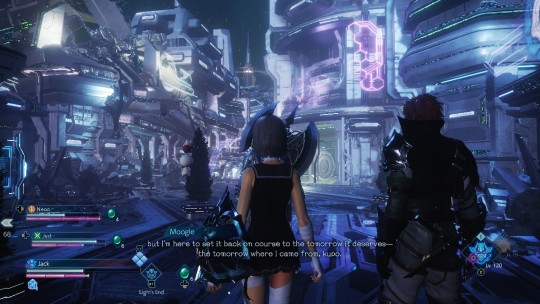
When the Moogle speaks to Jack it continuously speaks of a future, the one that it is to return to. While it doesn’t tell Jack all the details, it recaps the details of Dissidia NT’s story mode, heavily implying that that is the future it speaks of.
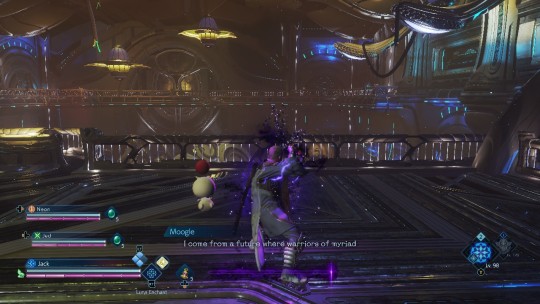
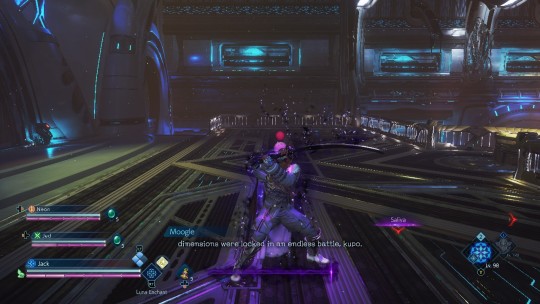
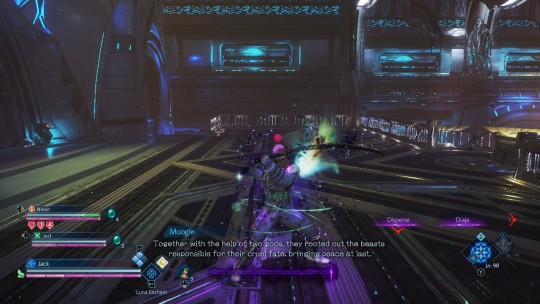
The missives explain that the Moogle was born from “the will of harmony” that exists within it and serves that will in place of “the two departed gods”. While we don’t know for sure where and why it needs new gods for World B (though my personal theory is between OG and NT), the bottom line is that it sees Jack Garland and his Warrior of Light as suitable candidates.
But what does one need to do to become a god of discord (or harmony)?
Part 2: Light & Dark
The balance between Light and Dark has been a recurring trend in Final Fantasy for ages. In the Dissidia series, this commonly takes the form of Harmony and Discord, which are represented by the two gods. In the Chaos Reports (which are no longer canon, but still worth mentioning) Cid notes that it is the opposing natures of Chaos and Cosmos that keep the realm stabilized. In the game itself, Cosmos’ plan to end the cycles is to more or less kill both gods, arranging for Chaos to kill her and trusting her warriors to kill Chaos. As Cid notes in the secret ending: The balance has been distorted. Even if Cosmos has been revived, the world is doomed to be destroyed. Cosmos’ description in Theatrhythm also describes her as one of the two pillars supporting the world, the other being Chaos. Finally, a cutscene towards the end of the game has Chaos speak with Garland about a dream he had: one in which he and Cosmos jointly governed the world and he suppressed disorder. He laments that dream, finding the happiness and warmth that he noticed from the people and Cosmos cruel to one who who has lost all memory.
Dissidia NT explores the concept of the gods having to jointly rule over the world. Materia and Spiritus are inheritors to World B, which is now sustained through conflict. While the gods are initially attempting to stamp out each other (Materia in particular is gung-ho about getting rid of Spiritus), their champions help the gods to realize that Shinryu is the true threat to the world. By the end, wielding copies of their champions (more on that in a bit) the two wage war on each other to build up the world, although Materia remains determined to someday settle the score with Spiritus, an attitude that he encourages. The ambiguously canon Dissidia Opera Omnia also explores the concept of the gods acting as pillars (literally, in the case of Act 4) as well as the possibility of the Warrior of Light and Garland doing the same at the end of Act 2.
On that note, there is the matter of the Warrior of Light and Garland. In the original game, both were more or less the champions or ‘right-hands’ of their respective gods. In some ways, they are the poster children for Harmony and Discord, and since the only such god that the player can fight is the one that closely resembles Garland’s empowered form, it goes without saying that they’re the main physical representatives of their respective sides. However, the Warrior of Light and Garland themselves have never been gods. While Opera Omnia comes the closest (and indeed, I spoke about it here) it doesn’t go the whole nine yards.
Still, this could be a reason the moogle settled on a variation of the Garland it knew: Since Garland and the Warrior of Light are the embodiment of darkness and light, versions of them that have reached the seat of divinity would be excellent choices to become the pillars of the future World of Conflict. However, unlike the originals, SoP’s world did not have the necessary components required to facilitate their appearances naturally: Jack and his allies were strangers and the game puts more emphasis on the darkness and chaotic emotions created by the crystals for Jack to absorb, instead of the powers of the crystals themselves. Likewise, the Warriors of Light seem to come from another world entirely, to the point that in one timeline, Jack and his friends gave into despair and degenerated into monsters because the Warriors of Light never appeared. Even when the Warriors of Light did show up, Jack was able to easily defeat even their strongest warrior.
One of the ways the Moogle settled this was by sending Cid Tonberrini to aid Jack Garland in the Dimensional Labyrinth: The weapons dropped by Gilgamesh are shown to Cid, who either takes them and offers something else in exchange or lets Jack keep them, powering him up. Of particular note are the Ame no Murakumo and the Excalibur.
The Murakumo unlocks the true potential of Jack and company, although Cid warns them that they’ll find themselves “dangerously close to the realm of the divine”.
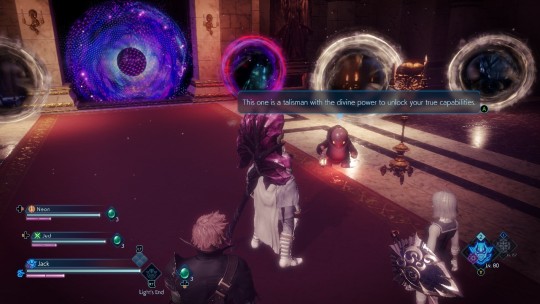
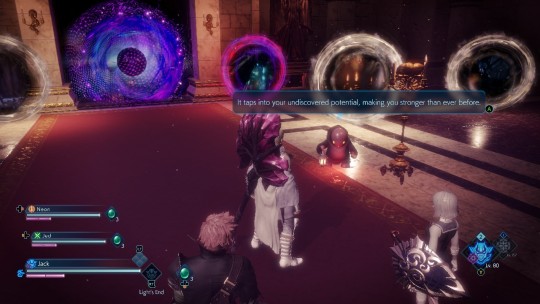

Meanwhile, the Excalibur is noted to be a true holy blade rather than an imitation or lesser version. While Jack can’t directly use it, Cid offers to teach Smith – the dwarven blacksmith from FF1 – how to make it, saying that the Warriors of Light will “become more powerful than you can possibly imagine”.
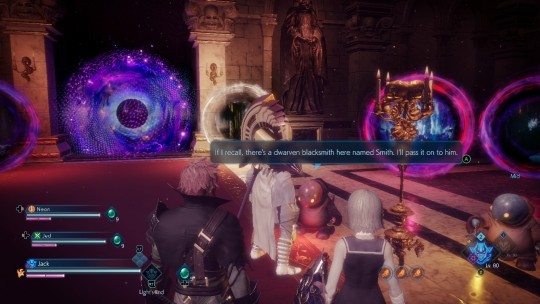

As for the second way...
Part 3: Divine Authority
As one of the Missives mentions, it is not enough for light and darkness to oppose each other. For Jack and his Warrior of Light to reach the seat of divinity, they themselves must be divinely anointed. To that end, the Moogle found the spirit of Bahamut – a variation of the recurring summon who was once worshiped by humanity until they overthrew and killed him – floating in the rift and sent him to Jack’s world.
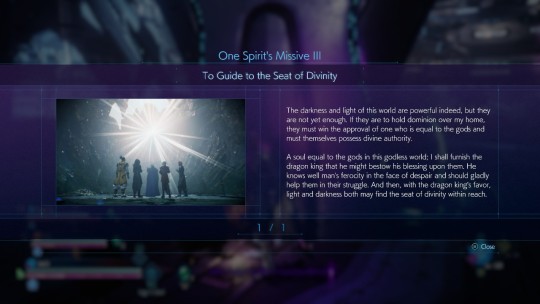
Jack and the Fiends manage to win Bahamut’s favor, not only receiving boons from the Dragonking, but enacting a deal so that he will do the same for the Warriors of Light.
In Dissidia, Chaos and Cosmos were originally unique manikins: Chaos having the memories of 10+ people and Cosmos being a ‘perfect manikin’ (or at the very least, a heavily custom one) in the visage of Cid’s wife. That’s not to say Chaos wasn’t strong: He was designed as a weapon and by all accounts was an effective one, even managing to seal away the summoned beasts and Omega. But he wasn’t the god of discord just yet.
Enter Shinryu. Shinryu is the recurring superboss of the series, introduced in FFV and is generally positioned as a godly creature (its arch nemesis, Omega, being positioned as a godslayer as a result). When Cosmos, Chaos and Cid made the deal, Shinryu blessed all of them; Cid gave up his physical form and became The Great Will while Cosmos and Chaos became the gods of Harmony and Discord respectively[1].
Materia and Spiritus had no personal anointment in the traditional sense. However, supplementary material suggests that they were born of Cosmos and Chaos’ wills, and possibly inherited their godly status. That said, the ambiguously canon Opera Omnia reveals that the gods are familiar with fellow god Enna Kros, giving an indirect endorsement.
All of this provides a second reason as to why Bahamut’s boons were critical: In addition to making Jack and his Warrior of Light stronger, it is a large step in both of them becoming divine. However, Jack would come into possession of another power critical to securing the future of the world of conflict – the ability to create life.
[1] The original Dissidia’s Chaos Reports, interestingly, make no mention of Cosmos and Chaos’ souls being elevated. In fact, it implies that they were already gods when Cid made the deal.
Part 4: Pawn Take King
The third DLC for Stranger of Paradise is a stage representing Lufenia Central. Throughout the stage, purple crystals are strewn about, which summon “Manikin” versions of enemies. This continues until Jack reaches his former boss, Nil, who has her own crystals; One of which allows her to make manikins of Omega. The Moogle notes in one of the missives that it is just like how the [REDACTED] of its world “created an ore from which they could forge an approximation of life “.
This section grew beyond the scope I originally intended, so you can find the full post here. The cliffnotes version:
Manikins were created by “The State” using the crystal ore discovered in World B and are a sort of artificial lifeform. They were considered for use in warfare, but had numerous problems, chiefly that they lacked a Will. Cid of the Lufaine was summoned in order to perform experiments to get them in a more usable state. One of the fruits of this experiment was the manikin that would be named Chaos: A manikin created from the memories of 10+ subjects who boasted immense power even before he became a god. The second result from this research is Cosmos, a perfect manikin modeled after Cid’s wife as a means to control Chaos after she refused to help “the state” further. Whose memories she is derived from varies depending on the game: In the original, it is implied that she was born from Chaos’ memories while in 012, it is stated in the final reports that she is derived from the memories of Cid’s wife. Either way, she resembles her original subject, but lacks the force of will that she had.
According to Cid, the key to making a successful memory transplant is to have an unclouded mind. After “the incident”, he decided to create another manikin much as he did with Cosmos to determine if the events of everything have left his memory unclouded. His initial experiments fail and it is only after he does a partial memory transplant rather than a complete one that he manages a body that doesn’t crystallize. Even then, the resulting manikin’s will is seemingly absent. Cid decides to place him in the cycles of conflict for observation. The manikin is found by two people: Prishe, who takes an interest in the new warrior and Garland, who seems to know him quite well...
In both “The State” and Cid’s research, failures that were unable to maintain a human likeness were disposed of via the Door to the Rift. They would eventually start taking the likeness of Cosmos and Chaos’ champions. During the events of 012, Exdeath discovered the door and the manikins within. Before long, most of Chaos’ forces were using manikins as minions. The manikins were so omnipresent and dangerous was such that the climax of the “Treachery of the Gods” storyline revolved around a number of Cosmos’ forces traveling to and destroying the Door To The Rift. This culled the number of manikins to more manageable numbers, at the cost of the champions themselves dying and being removed from the cycles.
The manikins return in Dissidia NT as minions. As I currently experience NT through the free version, I have no context for the manikins’ appearance in the storyline, if there is any. While not directly related to manikins (as far as we know), It is worth mentioning that Dissidia NT ends with the champions being presented with crystals. These crystals create copies of them to fight in their stead for the gods.
The manikins are one of the more harder to explain elements of the plan. However, given that World B subsists on battle energy by the time NT rolls around, it could be a means to provide further incentive to spark conflict. It may also be a means for Jack to create champions, just like how Dissidia NT ended, although this won’t be much of an issue given the next part...
Part 5: Rift Asunder
The other crystal the Lufenians possess is the Dimensional Matrix. The Matrix (no, not that one) is a device given to the Lufenians by Shinryu their mysterious collaborator and the means through which they are able to do their dimensional shenanigans. They can reset the world, i.e. “...travel backwards in time and reconstruct the world from a chosen point in the past”. The Lufenians use this tool to retool and remodel the world as they see fit; Initially, it was to fix the collapsing balance between light and dark, but as time went on, it was largely in service of their own experiments or ensuring that none of the ‘primitive Cornelians’ had a means of reaching and befouling their ‘glorious utopia’. At the climax of the game, Jack breaks into Station 19, absconds with the Dimensional Matrix (i.e. the Dark Crystal from the original game) and uses it as part of his plan to bring about the creation of the Warriors of Light. However, that was not the only matrix.
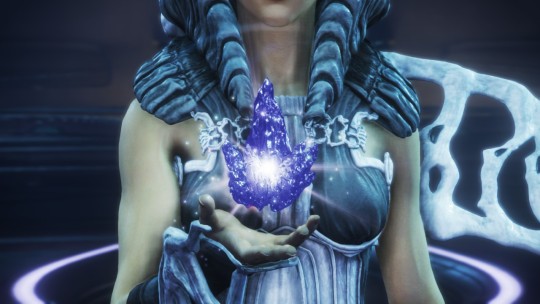
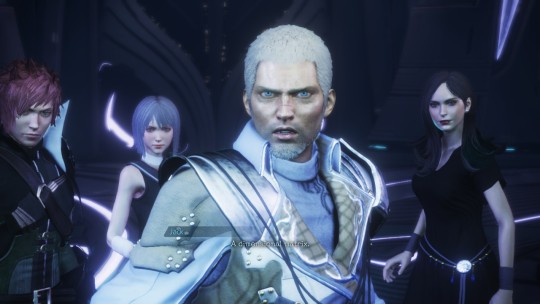
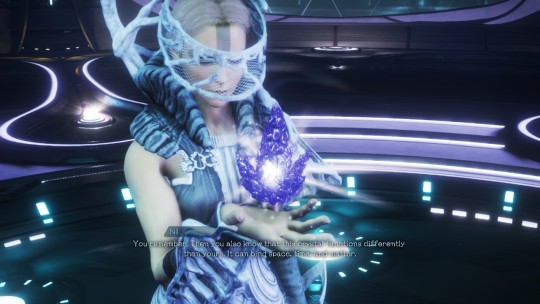
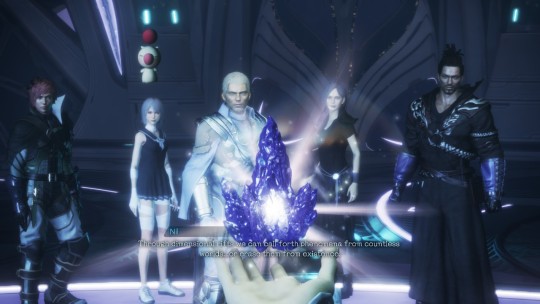
Nil, Jack’s boss prior to him going CHAOS, sends Lufenia spiraling into ruin to obtain an improved version of the Dimensional Matrix. Unlike the model that Jack stole, this matrix allows for significant manipulation of other worlds, opening rifts and summoning – or erasing – elements of the worlds beyond them. Wanderer of the Rift focuses on Nil bending space and time to ensure that Gilgamesh or Warmech the Death Machine kills Jack. By Different Future, Nil seeks to erase Jack’s world and begin from scratch using the Dimensional Matrix. She proceeds to give Jack a demonstration by summoning Omega to deal with him.
In Dissidia, the concept of interdimensional shenanigans is key to the backstory. A team in Onrac discovers a “door to the Rift”, which links to World B and leads to them finding the ore that becomes the basis for manikins. When Cid’s Wife is shot, Chaos creates a phenomenon that sends him, Cid and Cosmos to World B. The entire point of the cycles (in 012, at least) is to reopen the way to the Door to the Rift [2]. However, Exdeath and the other villains of discord find the door and the manikins sealed within it, giving them minions to use. During the events of Treachery of the Gods, Yuna, Tifa, Kain, Vaan and Lightning manage to destroy the Door to the Rift, stopping the manikins, but also destroying any hope Cid had of escaping the world. And, of course, the gods are able to summon their champions from other worlds. The Gateways in 012 are said to work due to a combination of the Door to the Rift, the summoned’s memories and Shinryu.
Needless to say, Jack having the ability to summon people from other worlds would go a long way to facilitating another war like the one Cosmos and Chaos waged.
[2] In 012, at least. In the original, it is implied in the reports that forging Chaos into the ultimate weapon took priority in Cid’s mind
Conclusion
To sum up The Moogle’s plan and how it echoes the events of Dissidia
- Two people to embody Darkness and Light are needed. The Moogle chose the right-hand men of both the past and futures gods to provide this: Garland and the Warrior of Light. Specifically, it chose Jack Garland and his Warrior of Light.
- They must hold great power to become worthy of godhood. The Dragonking’s boons and the weapons found in the Labyrinth greatly increase their power.
- They must be anointed by a godly being. A godlike version of Bahamut bestows his blessing upon them.
- Jack must gain the Lufenians’ crystal. One such crystal allows the user to create manikins to fight on their behalf, just as how Cid’s ‘failures’ populated the world after being released from the Rift.
- The other crystal allows for greater control over other dimensions, including opening doors to other worlds; Perfect for summoning pawns to fight on your behalf.
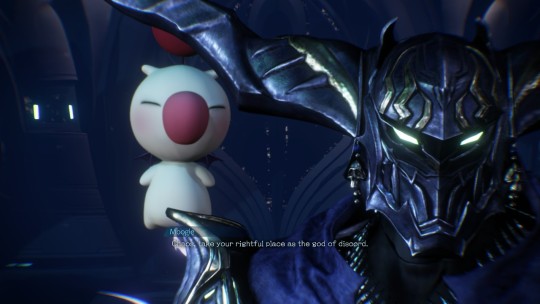
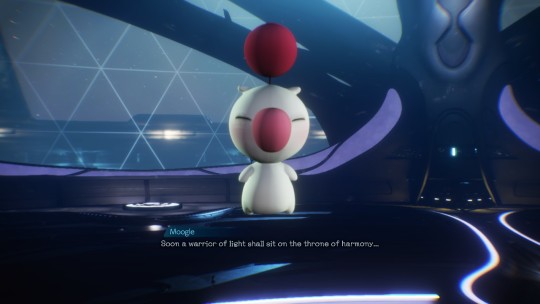

#stranger of paradise#SoP spoilers#Final Fantasy#dissidia final fantasy#Dissidia#Jack Garland#Warrior of Light#Moogle#Harmony#Discord#Bahamut
7 notes
·
View notes
Text
Wizardry Proving Grounds of the Mad Overlord Review (PlayStation 5)

Wizardry Proving Grounds of the Mad Overlord Review is a full 3D remake of the first game in the legendary Wizardry series of RPGs. The first party-based RPG video game ever released, Wizardry: Proving Grounds of the Mad Overlord was a direct inspiration to series like Final Fantasy and Dragon Quest. Digital Eclipse's revival preserves the appeal of the classic, with many upgrades for modern role-playing game fans.
Wizardry Proving Grounds of the Mad Overlord Review Pros:
- Beautiful graphics. - 1.45GB download size. - Platinum trophy. - First-person dungeon crawling gameplay. - Five save slots. - Two versions - Original (keeps the level layouts from the 1981 game) and Console (more complex and challenging level layouts). - Options - you can use the original settings, modern, console, or customize them to your liking. - Custom settings options - bient map, DUMAPIC map (gives graphical feedback of location, not Coordinates), conversion hints, bad stuff on party wipe, surprise round casting, hide and ambush action, enemy ID system, action redirection, run away in turn order, starting attribute points, level up attribute advancement, character age theming, in config, temple design, and character recruiting. - The initial party is a case of having a party picked for you or you can pick each member. - You have a main town where you choose what to do in between adventures. - Gilgamesh Tavern is where you go to add/remove or edit party members. - Training grounds are where you edit characters. - Adventurers is where you heal, level up, and sort out your spells, etc. - The Maze is the entrance to your next adventure. - Temple Of Cant is where you can restore and reassure t dead characters. - Boltacs Trading Post is the shop where you can buy and sell gear, identify treasures, and remove curses from items. - Old school feel from the atmosphere to the music and how the game plays, it's old but modern. - Does a cool thing of showing actions etc on a rolling old-school text table in the corner and shows how the game looked originally with its low graphic style which is how we played it back in the day. - The Bestiary fills in as you encounter people, creatures, etc. - When playing the game you have a map in the corner that fills in as you move around. - Has every element of an RPG. - You move step by step in the dungeon. - Unless you change the setting, you have to identify new enemies to learn about them. - It is so much fun to play. - The sense of adventure is just all-consuming, you want to check out every corner, every tunnel. - Turn-based combat and you have the traditional options of fight, run, parry, and identify. - I'm combat you set everyone's action all together then watch it play out. - All new powerful soundtrack. - Chests can be found or given as rewards and you may have to inspect them or disarm traps on them before you open them. - If you have ever played games like Etrians Odyssey then that's how the map uncovers and how the game plays out. - Handy quick select option for combat so you can just get on with it. - The game performs really well and shows off fantastic lighting. - Full running text commentary of combat. - The dungeons can actually shift and move around as you are playing. - Supports using the stick or d-pad for movement. - Camp can be triggered whenever you want and it's a good way to do quick inventory checks. - Every party member has their own character card showing stats and abilities. - The little old-school graphics layout can be enlarged to fill the screen or turned off. - At any time out of combat, you can leave the dungeon. Wizardry Proving Grounds of the Mad Overlord Review Cons: - No clear way to target particular enemies in a fight. - A lot to take in. - Cannot remap controls. - You have so many options and choices that it can take a few games to learn what's what and how you want to play. - You don't see enemies or what triggers encounters most of the time. - A built-in save and load system would have been a great help as you are never sure when it saves or what it saves. - Had it a few times where when looking at a chest I can move the options (disarm/open) but I also have a menu saying abandon or stay at the chest but that's what the X button does so I end up messing up constantly. It doesn't happen all the time just after a few failed disarm attempts. - Some of the fights go on for a really long time. - Finding hidden doors is just a case of seeing the prompt in the corner. - No combat speed option or ability to skip animations. Related Post: Warhammer 40000: Space Marine 2 New Multiplayer Modes Wizardry Proving Grounds of the Mad Overlord: Official website. Developer: Digital Eclipse Publisher: Digital Eclipse Store Links - PlayStation Read the full article
0 notes
Text
Fic Prompts: The Star Wars Wednesday Menace
(This came from a crack-treated-seriously idea I was throwing around with -- and at -- my friends where Vader didn't suppress his Anakin side as much as he thought, and he keeps finding himself amused by the trouble that pesky Death Star Pilot causes. Sometimes he lets him escape on purpose, just to see what he'll do next. He kind of tries to stealth-train him, like Maul and Ezra)
“Oh, the Force is certainly with you, boy.”
Vader easily sidestepped the blade with good humor and parried. “But you are no Jedi.”
“I will be!” the Boy snarled.
Oddly, that seemed to make Vader almost falter.
“You’re...very certain that’s what you want?” he asked suddenly. He caught the Boy’s blade on his own and held it effortlessly. “Have you truly considered the cost of such a commitment?”
The Boy -- one of these days Vader was actually going to learn his name -- glared up at him from those too-familiar eyes. “Scared of what I’ll become, Vader?”
It was a childish taunt, and not one that should have rankled. And yet, somehow, it did. What would the Boy become? Vader pressed his attack a little more forcefully than he needed to. The Boy stumbled, barely able to parry in time.
“You are naive!” Vader snarled. “You play at war like it’s a game! Knights and dragons, like the child you are!” He swung, and the Boy ducked quickly. “Do not be so quick to swear oaths of loyalty to Orders you know nothing about! You do not yet know what you will be asked to sacrifice in return.”
The Boy was taken aback by this. He drew back a foot or so, holding the lightsaber in a guard position. He was cautious now, more so than before. He tilted his head and blinked slowly -- curse him, why did he have to look so much like Anakin he had once imagined his child might? Why was he so familiar?
“You aren’t talking about me, are you?”
Vader cursed himself, and the Boy, and that inconvenient soft spot he’d inexplicably developed for an enemy.
“Your insight serves you well,” he grudgingly allowed. “Behold: a cautionary tale made flesh. Do not put your trust in the wrong people, Boy.”
“Will you stop calling me that?!” the Boy protested.
Vader scoffed. “I do not know your name. What else would I call you?”
The Boy opened his mouth to argue, and abruptly closed it again. After a moment, a shrewd light entered his eyes. Vader had seen that look before. It usually heralded the little Rebel doing something infuriating and yet endlessly amusing.
“I’ll tell you my name, Vader,” the cunning brat offered, “After you tell me why you’re a cautionary tale.”
“You are blackmailing me?” Vader casually twirled his lightsaber and circled the Boy. “Ha! You imp. Very well, but do not think I’m going to let you live long enough to tell your Rebel friends.”
The Boy mimicked the twist of his blade -- much more smoothly this time! He was progressing! -- and flashed a cocky grin. “Yeah? That’s the same threat you made the last time I escaped. And the time before that.”
“True, that is true,” Darth Vader acknowledged. “You are becoming quite accomplished at that.”
Indeed, the last time I did not even have to help you “escape”.
He thought for a moment, then switched off his blade. Their battlefield was so cluttered with the collateral damage of a Rebel skirmish that it was not difficult to find a still-smouldering piece of an AT-ST to sit on.
Why did he feel the need to advise this young Rebel? What purpose did it serve to coddle him so much? If he was just going to take him as his apprentice either way, he didn’t really need to put so much effort into winning his trust, did he? Well, perhaps he did. It was clear that the Boy was learning in leaps and bounds from their little game, though he would no doubt be loath to admit it. He wanted to outdo Vader. Spite was a very effective motivator.
And besides, perhaps playing the mentor just a little more than usual would serve to make the Boy drop his guard just that little bit more.
That didn’t mean it was a story he liked to tell. But he had come too far to back down now.
“I...once trusted a man to save my family from imminent death,” Vader said slowly. Reluctantly. “I first went to the Jedi. Yes, your beloved Jedi, for help. And they advised me to “let go” and allow my pregnant wife to die.”
He sensed confusion from the Boy. Then disbelief and suspicion, slowly leveling out into recognition that he was telling the truth. That, and dull horror. Well, that was a bit more validating than he’d expected, wasn’t it?
“The Jedi failed me, Boy. And so I turned to the Sith. He had the power to preserve one’s life force, by drawing on the Dark Side of the Force. He still does, in fact. I have witnessed it.”
“Oh. Great.” The Boy shuddered. “That’s...good to know.”
“Such was my thought. But as you do not seem to understand yet, despite your accent clearly marking you as coming from Tatooine, nothing is done for free. There is always a price, Boy. Always.” Vader turned the hilt of his saber over in his hands slowly. “To prove my loyalty, I was commanded to kill the Jedi. All of them. And I did so, without question: he insisted that I wholly cut myself off from my past so that he could be assured of my future loyalty. Only then would he fulfill his side of the bargain.”
The Boy took another step back, repulsed. “You...you killed hundreds...thousands of Jedi...because someone told you he refused to save your wife and baby otherwise? You just handed your family over as hostages because somebody said they could help you? That’s a Hutt’s bargain, are you nuts?! Why didn’t you just take her to a doctor?!”
Anger crawled up Vader’s throat like acid. The Boy did not know what he was talking about. Nor did he seem to remember to whom he was speaking. You will learn, my reluctant apprentice.
“Doctors do not understand ailments predicted by the Force,” he said harshly. “No one else was willing to help me but an old mentor and scholar with seemingly noble purpose. Does that not seem familiar to you? I rashly swore my allegiance just as you seem to have.”
With a hiss, the Boy’s lightsaber flicked off and hung useless at his side. He sank into a crouch, just watching him. Those eyes, Anakin’s eyes, held a terrible, knowing, look. A haunted look.
“He didn’t save her, did he?” the Boy whispered.
He sounded as though he wanted to be sick.
“No, Boy. He did not.” Vader’s fists tightened over the hilt with a creak. “But by then, I had cut off my own retreat. There was nothing else left but my vow to his Order.”
It burned, even letting someone he intended to take as a padawan know anything about his past. It burned to admit that he had been deceived. That he had met the fate he tried to avoid on the path he took to escape it. It stung that this Rebel’s child was nearly the age The Baby would have been.
The Dark Side flickered warmly around him, taking his pain and anger and sorrow and exchanging them for raw power. Padme was gone -- forever beyond his reach. As was the child he had never gotten to meet. To hold.
“That’s why you killed him?”
Vader looked up in time to see the Boy grit his teeth and turn his face away.
“It’s not fair.”
“What is not fair?”
A spike of anger, bright and sharp, burst through the Force for a moment.
“Why was my family less important than yours?” the Boy challenged. “Why, Vader?! I lost my father because you thought you might lose your family?”
“I did lose my family!” Vader roared. He leapt up, blade at the ready again. “What do you know of such matters? Tell me! What would you have done for a chance to save your father, Boy?”
He brandished the lightsaber threateningly. “Speak up! Look at you. Look at me! That you are so eager to avenge him is answer enough.”
He stormed forward before the Boy had a chance to stand, and leveled his sword at the Boy’s throat. “Do not be so quick to deal out judgement, Boy,” he hissed, “You are already blindly following a path not unlike mine.”
The Boy stared mutely up at him with wide, panicked eyes. His presence in the Force reeked of fear, and the Dark Side absorbed it eagerly. Darth Vader contemplated killing him then and there. But his hand would not move. He knew full well that he couldn’t make himself do it. Not when he’d already put in this much effort to teach the boy.
With a disgusted sound, the Sith deactivated his lightsaber and turned his back on the Boy.
“Go,” he growled, “Before I change my mind.”
The Boy scrambled to his feet and wasted no time in getting out of range. Strangely, at the very edge of their battlefield, he hesitated.
“Leave me!” Vader snarled at him.
There was a limited time before his temper snapped. If the foolish child didn’t get out of the way, he would only have himself to blame.
“Skywalker.”
The world stopped, like an unwound clock. Even the motes of dust seemed frozen in place. Blood roared in Vader’s ears as he slowly turned to look up at the boy at the top of the crater.
“What did you say?”
The Boy raised his chin.
“My name. It’s Luke Skywalker.”
He didn’t wait to see if the name rang a bell. He didn’t stop to ask if Vader remembered his father yet. He just ran.
Darth Vader stood motionless in a field of debris.
Skywalker.
Skywalker?!
LUKE.
The name that she’d picked!
The face that seemed so familiar-
His eyes-!
Barely twenty.
He was barely twenty.
The pieces fell into place almost too quickly, carried along on the reproachful whisper of the Force. Light Side or Dark, he could not tell.
And you just let him go like this?
Vader whirled.
“Luke!”
#star wars wednesday#star wars au#accidental apprentice au#luke skywalker#darth vader#darth vader accidentally adopts his own son#luke isn't thrilled#inspired by gilgamesh from the final fantasy series#a darth vader who's a terror to the ones he hates but he's almost good-natured with the ones that amuse him#fic prompts#writing prompts#the Accidental Apprentice AU idea is an open sandbox! Have fun!
434 notes
·
View notes
Text
ScottyMcGeester Plays Every Final Fantasy Game*
*Okay, all the main games except 11 and 14 since they are online only, and also no spinoffs or sequels.
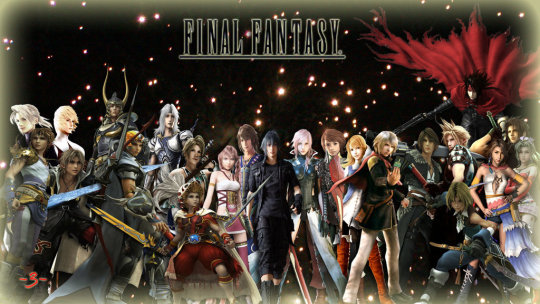
THE INTRODUCTION
Years ago, I had a goal to finish every Final Fantasy game. As of December 30, 2020, I finally reached that goal. I originally started posting these reviews way back in 2017 on VGF(VIdeo Game Forums), and posted one review after another as I completed each game. I had already finished a few before I started reviewing the series, such as Final Fantasy I, II, VI, IX, and X.
Final Fantasy X was my very first Final Fantasy game, way back when it first came out on the PS2. It took me years to finish that game, mostly because I was still a novice at RPGs and I didn’t quite know what I was doing. Still, the world and concepts of Final Fantasy gripped me. As a sci-fi/fantasy writer, they inspired tons of elements in my stories. The series spans a multitude of genre-bending stories – sci-fi, fantasy, some steampunk, modern fantasy, space, traditional fantasy with knights in armor – and a whole lot of crystals. I wrote these reviews as if you have no idea what Final Fantasy is – whether you are a gamer or non-gamer. This first post is a general introduction to the series as a whole, but even if you are a die-hard fan already, there are some things that I explore that I hope you'll find interesting. What is Final Fantasy? Final Fantasy is a roleplay video game series that started back in 1987. The first game was reminiscent of Dungeons and Dragons, where you could choose one of six roles for a team of four: White Mage, Black Mage, Red Mage, Thief, Monk and Warrior. Square, now known as Square Enix, developed the game. A legendary rumor about the title “Final Fantasy” comes from the story that they were on the verge of bankruptcy. They only had money for one more game, a fantasy game. They dubbed it “Final Fantasy.” This apocryphal story is nowhere near true. Square had made video games before and they didn’t do well, but the company itself wasn’t on the verge of bankruptcy. What happened was that the developer, Hironobu Sakaguchi, had planned to retire. He didn’t see any foreseeable future in video gaming with Square’s mediocre performance. He wanted to make a fantasy game and dubbed it “Final Fantasy”, since it was to be his personal last work. He also wanted the game to be abbreviated as “FF” – they originally had “Fighting Fantasy” in mind but that name was already trademarked by a board game. Final Fantasy initially sold 400,000 copies in Japan and became and instant hit. Nintendo of America approached Square to release a localized version for the states. Final Fantasy became far from Sakaguchi’s last game. What’s Final Fantasy about? Every main Final Fantasy game has a new story with new characters and even new gameplay. Some games have direct sequels and are recognizable with a subtitle, or an additional number following a dash. For example, there is Final Fantasy VII, and the direct sequel to that Dirge of Cerberus: Final Fantasy VII. There's a direct sequel to Final Fantasy X titled Final Fantasy X-2. But even though each Final Fantasy game is different, there are still central elements that make them a Final Fantasy game. You can’t just write up a random fantasy story and slap the Final Fantasy name on it. The following elements are what make a Final Fantasy game. Some are obvious while others not so much. Chocobos:

Chocobos were first introduced in Final Fantasy II, but have been present ever since. They are cute, large birds that the characters often ride across fields or sometimes call into battle. They have practically become the mascot of the series. Moogles, Cactuars and Tonberries – oh my!
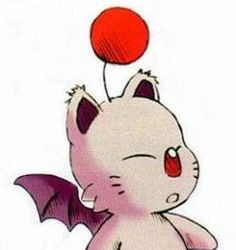
Moogles (pictured above) are telepathic creatures that help the players, or sometimes they can be a playable character. They debuted in Final Fantasy III.

Cactuars (right) and Tonberries (left) are cute, unassuming enemies that are actually highly dangerous, killing you in one shot if you are not careful or fast enough. The former debuted in Final Fantasy VI while the latter debuted in Final Fantasy V. Summons:
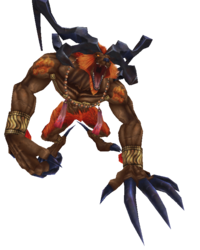
Sometimes they go by different names, like eidolons or espers. Summons are massive, fantastic beasts that you can call upon to aide you in battle to fight the enemy. Summons became a staple ever since Final Fantasy III. In some games, they are merely there to call into battle, while in other games they are central to the story. Airships:

Airships have been present since the first game. They are massive boat-looking airplanes. In the more recent games, airships look almost like spaceships.
Cid:
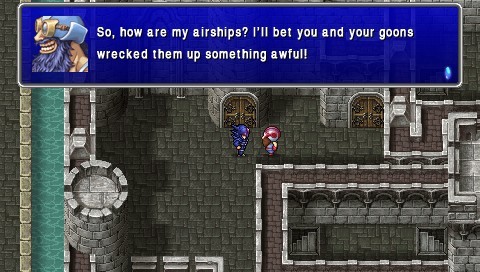
With the exception of the original Final Fantasy (except in later remakes), every game has a character named Cid. Cid is typically the character who owns an airship.
Items and Magic Spells:
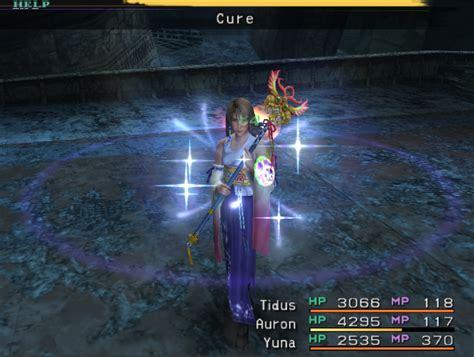
Each game shares virtually all the same items and magic spells. Antidotes. Eye drops. Maiden's kiss. Holy water. Phoenix Down is well-known for reviving knocked-out characters in battle. The spells follow a hierarchy of levels. For example, Cure is the basic spell to heal somebody. The second level spell for healing is Cura. Then Curaga. Then finally Curaja. Most other spells follow the same format. The same high-level spells also frequently appear throughout the games, such as Holy and Flare.
Crystals:
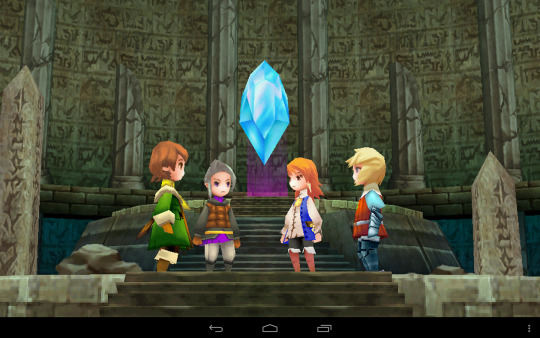
With a few exceptions, crystals appear in nearly every game. They often serve as plot devices, whether they be the force that protects the planet or powerful objects coveted by the enemy. They also oftentimes have a consciousness of their own, communicating with the characters and calling them to their destiny.
Mythological References:

Final Fantasy is riddled with mythological references. Many summons and creatures take the names of mythological creatures or deities, such as Shiva, Bahamut, Leviathan, Behemoth, Odin, and Ifrit. Certain villains share the names of mythological figures or they are derived from certain mythological concepts, such as Gilgamesh and Sephiroth. Many of the games have legendary weapons you can find near the end of the journey. These are typically named after legendary Japanese figures, such as Masamune and Yoichi, or other world mythologies, such as Thor’s hammer Mjolnir. Saving the World:

Final Fantasy isn’t about saving a particular princess, or person for that matter. The ultimate goal is to save the entire world, or even the very fabric of reality. Evil spreads in many ways, such as a sealed darkness trying to break free, empires with ambitious goals, villainous subordinates who pull the strings of politics, or empires destroying the environment. Typically, the main cast consists of characters from all walks of life. They all have to learn to work together and get through their personal struggles to save the world. Existential Crisis (or Startling Revelation):
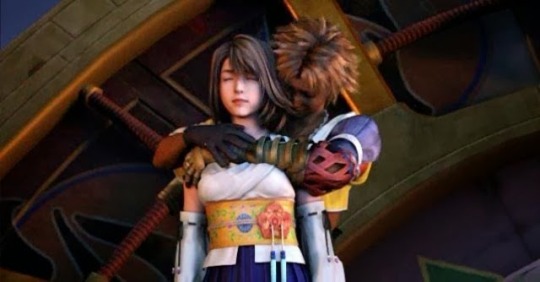
By the time you reach the third act of a Final Fantasy game, some startling revelation forces the characters to question their very existence. A villain is revealed to be a hero’s family member, a main character realizes they're a clone, another realizes that they cannot live without magic, etc. Typically, the main character questions the nature of their soul, if they die like regular beings and become part of some greater life force, or blink out into oblivion. Whatever the revelation may be – it serves as a final crisis that the characters have to overcome. The Descent into Hell:

Every third act of a Final Fantasy game ends with what I like to call a “descent into hell”. The final dungeon is always some kind of bizarre world. In Final Fantasy II, you literally descend into hell to fight the Emperor. Throughout the series, hell is more metaphorical. The final dungeons can be a massive, sprawling tower or dreadnought, or a strange dimension that appears to have no rhyme or reason. Sometimes I'm reminded of M.C. Escher’s work, “Relativity”, or sometimes it reminds me of some cosmic horror featured in the Cthulhu Mythos. These final dungeons can be inter-dimensional rifts between space and times, pockets in reality, subterranean depths, insane worlds that the villain created, and worlds of darkness. (Final Fantasy IX's Memoria)

(M.C. Escher's “Relativity”)
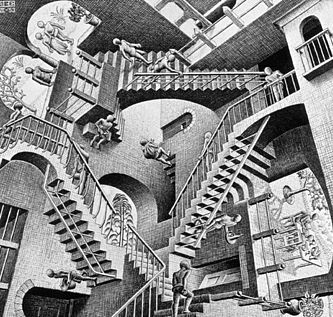
These stylistic approaches for the final dungeon represent the oncoming battle with the forces of chaos. Fighting God:
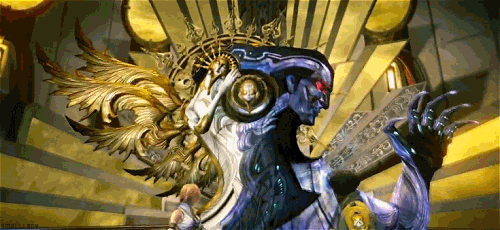
After venturing through the surreal and hellish final dungeon, you face the main villain. The main villain always achieves godlike status or the characters actually have to defeat a god in order to save the world from its oppressive reign. Many stories appear to throw in a last minute ultimate god who was pulling the strings of the plot the entire time. The purpose of dealing with gods and goddesses represents the characters’ desire to control their own fate and alter their destiny. Most of these bosses are strange and grotesque, definitely getting a Cthulhu vibe from them. I looked at them and thought, "Christ, what the hell is THAT supposed to be?"

It always feels like THE final fantasy:
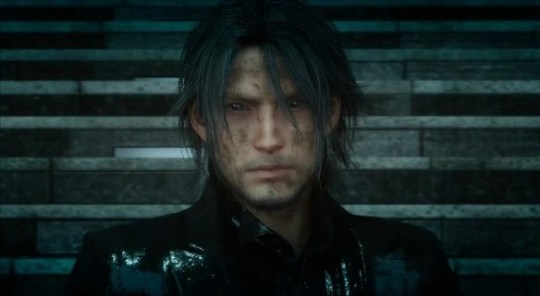
Each game, no matter what happens or how it happens, feels like the be-all-end-all of its story – its fictional universe. Direct sequels were unheard of until Final Fantasy X-2, which while fun, was wildly different in tone from the original game, and critics pointed out that it ruined the finality of Final Fantasy X. This is one reason why I think direct sequels to Final Fantasy games fail – what else could the main characters possibly face that is more dangerous than the one they just encountered? Anything else would feel like child’s play to them. NOTABLE PEOPLE Aside from the characters, stories and games themselves, the people behind the series have achieved legendary status. Nobuo Uematsu:

The original composer of Final Fantasy. Uematsu single-handedly scored the first 9 Final Fantasy games. Uematsu surprisingly never had any formal training in music – a trait that would ostracize any composer, such as Danny Elfman. I find that the those who haven't had any formal training usually break the mold with music. Uematsu started working for Square at around 25 for the first Final Fantasy game, starting out with nothing and never suspecting his job would lead him where he is now. His music is unique for incorporating elements of classic and progressive rock, specifically in the battle themes. Uematsu’s themes for each game have achieved instant recognition in the gaming world, as recognizable as the theme to Star Wars or James Bond. Tetsuya Nomura:

Tetsuya Nomura is a video game designer and director who started at Square in 1990. He rose to prominence when he was given full control of designing the characters for Final Fantasy VII – arguably the most popular Final Fantasy game to date because of its characters: Cloud Strife, Tifa Lockhart, Vincent Valentine and Sephiroth. Nomura went on to create more legendary characters for Final Fantasy VIII, X and XIII. Yoshitaka Amano:

Amano is the artist whose work is most known now in Final Fantasy. He has done concept art and design for every game in the series. His style is instantly recognizable. He has also drawn for many anime shows, comics and mangas, such as Vampire Hunter D and Sandman: The Dream Hunters.
And last but certainly not least - THE MUSIC Final Fantasy has left its mark in the musical soundtrack of video games. Each game more or less shares three of the same memorable tracks.
The Prelude:
youtube
The Victory Fanfare:
youtube
The Final Fantasy Main Theme:
youtube
THE REVIEWS
Each review I post will critique major aspects of each Final Fantasy game, such as its gameplay, graphics, story, and music. Today is currently January 3, 2020 (technically the 4th when I post this because it’s past midnight), and I will be posting one review per day so as to not lose my sanity editing and formatting everything at once here. So look forward to the very first review tomorrow starting with the very first Final Fantasy game.
#final fantasy#final fantasy v#final fantasy vi#final fantasy vii#final fantasy vii remake#final fantasy xv#final fantasy xvi#tifa loc#cloud strife#sephiroth#nobuo uematsu#video games#sony playstation#playstation 5#final fantasy x#onvideogames
119 notes
·
View notes
Text
Final Fantasy’s Multiverse Fan Theory Will Change How You Look at the Franchise
https://ift.tt/3C7lXDN
Many beloved video game franchises try to maintain a semblance of continuity and worldbuilding. Usually, those attempts consist of linear a-to-b narratives across sequels, but there are times when the connections between games in a franchise can be a bit perplexing. For instance, each Legend of Zelda game seems insular at first, but they actually take place in a shared world and timelines. The timeline barely makes sense, but it’s there. Final Fantasy, meanwhile, seemingly reinvents its wheel with each entry. Every title takes place in its own world with its own history and lore that is, on paper, completely separate from the rest of the series.
If you scour Reddit and other internet forums, though, you may eventually find theories that claim the Final Fantasy franchise utilizes one big, interconnected multiverse. A popular variation of that belief purports that Final Fantasy XIV sits in the center of that universe or that other titles sprung from that game’s world.
In fact, many players who have extensively explored Hydaelyn and the other worlds of Final Fantasy (not to be confused with World of Final Fantasy) eventually reach the same conclusion: Final Fantasy exists in some kind of multiverse. Do those claims and theories have any merit, though, or are audiences letting their apophenia take them for a joyride? Let’s try to find out together.
Final Fantasy’s Familiar Faces
We might as well get the most obvious evidence for a shared multiverse out of the way first. If you’ve played more than one Final Fantasy game, you probably know the series has a lot of recurring elements (such as Chocobos, Behemoths, and engineers named Cid). However, some common elements go deeper than shared names. Sure, every now and then unrelated characters will sport the same moniker for the sake of references and callbacks (such as Zeromus from Final Fantasy IV and Zeromus from Final Fantasy XII) but some recurring faces who only seem like they exist for the sake of tradition actually help tie the games together.
The first recurring character we have to talk about is everyone’s favorite pillar of buffoonery, Gilgamesh. In virtually every entry, he is portrayed as a bumbling wanderer who seeks power through collecting weapons. Moreover, most Gilgamesh incarnations sport the same red hood, kabuki face paint (sometimes a mask), and awesome battle theme that transcends music genres, but that isn’t because Square Enix is lazy. The majority of Gilgameshes tend to appear and/or disappear into an Interdimensional Rift (more on that later). That implies they’re the same character in an unending, world-hopping obsession for new weapons.
Indeed, after Gilgamesh is beaten in Final Fantasy IV: The After Years, he cries out the name of Final Fantasy V’s protagonist, Bartz. In Dissidia 012 Final Fantasy, Gilgamesh claims to have dueled “strange opponents” countless times. If that’s not enough for you, consider that in later entries, Gilgamesh wields replicas of weapons from past Final Fantasy games. Gilgamesh doesn’t just talk about the Final Fantasy multiverse; he almost literally beats players over the head with it. However, Gilgamesh isn’t the franchise’s only cross-dimensional tourist.
Whenever you finish a Final Fantasy story and beat the final boss, each game offers additional challenges in the form of “superbosses.” One of the franchise’s most consistent superbosses is the quadrupedal robot known simply as Omega. Throughout its various Final Fantasy appearances, Omega’s physical appearance is portrayed with a startling amount of consistency. However, the robot’s true nature is a bit more up in the air. As some fans have discovered Omega has two possible incarnations: shards left behind to collect data and demi-knockoffs created by local geniuses who drew inspiration from the original Omega. Either way, Omega is a dimension-hopping robot whose sole purpose is to defeat its arch-nemesis, Shinryu. According to lore provided by games such as Final Fantasy XIV and Dissidia Final Fantasy, every Shinryu that players face is also actually a minor fragment deposited to help the original grow stronger.
It’s certainly harder to argue against a multiverse when you have three recurring characters that practically rely on it for their motivations and design.
Dissidia Final Fantasy Wouldn’t Exist Without a Multiverse
When Nintendo set the world on fire with the Super Smash Bros. franchise, other companies started making their own mascot fighter game that they hoped would print money. Square Enix’s Dissidia Final Fantasy set itself apart with a vastly different combat system. However, Dissidia’s bigger claim to fame is its story, which breaks from mascot fighter tradition by leaning on and expanding its source material’s canon (especially the parts that concern the multiverse).
Since Dissidia is a spin-off, you’d probably assume it exists outside of the Final Fantasy canon with character facsimiles standing in for the original protagonists. After all, that tends to be the industry standard (Nintendo’s Shigeru Miyamoto once confirmed that Super Smash Bros.‘s characters are actually toys). However, Dissidia’s fighters are surprisingly the real deal. That’s because, according to the narrative, the real Final Fantasy characters have been summoned from their own worlds to fight on behalf of the gods in Dissidia’s World B. Every Dissidia game starts off with this statement, and, in fantasy properties, disparate worlds usually imply a multiverse. Since there are three Dissidia games (four if you count the mobile entry), the entire franchise is arguably one big multiverse confirmation.
Moreover, Dissidia goes several steps further since World B is a near-geographic replica of the first Final Fantasy’s setting, World A (albeit dotted with arenas ripped from the fragmented memories of its characters without rhyme or reason). For instance, one of the battlegrounds in World B is a blasted moonscape. Why is a location like that on a planet with an atmosphere? Well, it’s because it was pulled from the memories of Cecil Harvey: a character who traveled to the moon in Final Fantasy IV. Without a multiverse, there would have been no memories to pull from.
Now, since characters die left, right, and center in Dissidia, you might wonder how the series canonically fits into the Final Fantasy franchise without shattering the space-time continuum. Well, time works differently in World B, and that plot point is used to insert new canon into older titles. Everyone is caught in an endless cycle of battles, death, resurrection, and amnesia. They barely remember where they came from or why they are fighting and just know that they need to fight. But, after what is implied to be countless cycles worth of combat, the first game’s ending explicitly states that the various heroes and villains return to their respective worlds. Everyone except for the Warrior of Light, that is. He was created on World B by Cid of the Lufaine (a character retroactively added to rereleases of the first Final Fantasy) and retconned into one of the World A’s heroes from the original Final Fantasy. From there, Dissidia Final Fantasy NT pulls them all back for one more round.
Without a Final Fantasy multiverse, Dissidia wouldn’t make a lot of sense and would certainly be a very different spin-off series from a narrative standpoint.
Read more
Games
Was Final Fantasy Really the First JRPG?
By Matthew Byrd
Games
25 Best RPGs Ever Made
By Matthew Byrd
Final Fantasy XIV and the Collaboration Connection
Now that we’ve established the general existence of a Final Fantasy multiverse (or the strong possibility of its existence), it’s time to address a particularly popular fan theory question: Is Final Fantasy XIV the root of the Final Fantasy multiverse?
It’s no secret Square Enix loves to stuff Final Fantasy XIV full of collaborative content. Players have gone on quests and collected equipment ripped out of properties such as Yo-Kai Watch and Garo. Square Enix also tends to collaborate with…well…itself and place the results in Final Fantasy XIV. For instance, Lightning and Noctis showed up for limited-time events in the game, but those instances hardly prove that the game sits in the middle of some kind of Final Fantasy nexus. After all, Lightning can don the iconic getups of characters such as Cloud, Yuna, and Lara Croft in Lightning Returns: Final Fantasy XIII. Does that mean her tailor lives in the center of a Final Fantasy or Square Enix multiverse? Probably not since those crossover costumes are all optional DLC (and ultimately probably meant to advertise different Square-owned games). All Lightning and Noctis demonstrate in their Hydaelyn vacations is how the different Final Fantasy worlds are connected.
Lightning and Noctis visited Hydaelyn thanks to the Interdimensional Rift (the same one Gilgamesh, Omega, and Shinryu use to get around), and they aren’t the only characters who have taken an interdimensional tour. The Stormblood expansion introduced the Aetherial Rift: a raid dungeon hosted by a surprisingly friendly Omega (friendly in that he tests players before trying to stomp them out of existence). Thanks to Omega’s control over the Rift, gamers can square off against recreations of past Final Fantasy game bosses, including Chaos, Kekfa, Exdeath, and the Phantom Train. Again, you might assume these crossovers imply that Hydaelyn rests at the center of the multiverse. Instead, they most likely suggest that Omega either visited or used networked knowledge of different worlds to create these arenas, which lends credence to the theory that most Omegas seen throughout the franchise are either the same killbot or are linked in some way. Square Enix also apparently just loves to reference/advertise its older titles.
Now, some of you might ask, “What about Ivalice? Doesn’t Ivalice’s presence in Final Fantasy XIV prove the game is smack dab in the middle of the Final Fantasy multiverse?” Again, no. The Ivalice you’re thinking of is the world from Final Fantasy XII, while Ivalice in Final Fantasy XIV is just a kingdom. Confusingly, both Ivalices share certain elements, such as the Viera and Yiazmat, but those shared elements don’t necessarily demonstrate worlds colliding. Instead, they are likely indicative of design singularities you usually see in multiverses from other franchises (multiple Marvel universes have a Spider-Man/Woman, and multiple Final Fantasy universes have an Ivalice).
Final Thoughts on Final Fantasy‘s Multiverse
Considering the Interdimensional Rift and characters such as Gilgamesh and Omega, you really can’t argue against the likelihood of some kind of Final Fantasy multiverse. However, is Final Fantasy XIV really at the center of it all? Elements from different entries (as well as unrelated games, such as NieR:Automata and Monster Hunter: World) are certainly more likely to bleed into Hydaelyn, but does that make it the center of the multiverse? Signs point to no. Odds are Final Fantasy XIV’s above-average interdimensional crossover rate is merely a result of its MMORPG nature and good old-fashioned marketing.
cnx.cmd.push(function() { cnx({ playerId: "106e33c0-3911-473c-b599-b1426db57530", }).render("0270c398a82f44f49c23c16122516796"); });
At the end of the day, it doesn’t matter which Final Fantasy world, if any, spawned the others. They all are clearly interconnected through countless narratives and world-building elements, so unless Square Enix reveals the identity of this fabled origin world, all we can do is speculate. Then again, if we knew which Final Fantasy universe spawned the others and exactly how the game’s multiverse elements work, that might suck some of the magic out of the series.
The post Final Fantasy’s Multiverse Fan Theory Will Change How You Look at the Franchise appeared first on Den of Geek.
from Den of Geek https://ift.tt/3nvYjNk
2 notes
·
View notes
Text
LONG Character Survey: Lyllyan Weiss
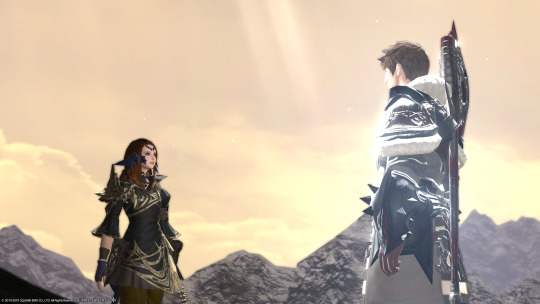

BASICS.
FULL NAME: Lyllyan Aster Weiss
NICKNAME: Lyl, Lily, Lil' Lily.
AGE: 21
BIRTHDAY: 11th Sun of the 6th Astral Moon (November 10th)
ETHNIC GROUP: Auri|Xaela (In Eorzea)/ Human (Out of World)
NATIONALITY: Eorzean (In Eorzea)/American (Out of World)
LANGUAGES: Eorzean, Draconic, basically anything due to the echo.
SEXUAL ORIENTATION: She is Bi. Swings both ways. She loves all.
ROMANTIC ORIENTATION: Biromantic
RELATIONSHIP STATUS: Depending on the different routes on the story, she will be either single or taken.
CLASS: Jack-of-all-trades
•Knows everything and knows how to play everything.
• Favors caster classes above everything else.
HOMETOWN / AREA: N/A
CURRENT HOMETOWN / AREA: Shirogane is where her apartment is, but she sees Ishgard as her home that she spends her time in, and then the Crystarium had became home to her as well.
PROFESSION: Scion, Adventurer, Full time hero in both her world and Eorzea. In her world she is a waitress and an artist/animator.
PHYSICAL.
HAIR: Right now it is Brown with Light brown Highlights
EYES: Purple (Right), Green (Left)
NOSE: Small and Sharp
LIPS: Small and full
COMPLEXION: Pale but fair.
BLEMISHES: None.
SCARS: In Eorzea, her scars are battle scars that is more aligned on her back. They do not show up when she is in her world.
TATOOS: The Scion Tatoo on the part where the neck and back meet.
HEIGHT: 5'0
WEIGHT: 130lb (Eorzea)/ 150lb (Her World)
BUILD: Short, Thin and fit.
FEATURES: None really.
ALLERGIES: Rolanberries in Eorzea, Strawberries in her world.
USUAL HAIRSTYLE: Long hair with a half braid in the back in Eorzea. In her world she has short hair that stops in the middle of her neck.
USUAL FACE LOOK: Warm color Eye shadow applied lightly to the eyes and a very nude color for lipstick in Eorzea. In her world, she hardly puts make up on, but usually has dark circles due to being tired all the time.
USUAL CLOTHING: Depending on her mood, she'll go very modest, or wearing a bikini with thigh boots. In her world, she is always modest with usually a t-shirt and sweats.
PSYCHOLOGY.
FEARS: Bugs (Mainly Arachnids, spiders are the worst.) Antilions that hide in the sands. Losing her love ones. Becoming Sin Eater. Being alone. Falling.
ASPIRATIONS: Explore all of the worlds she could go to, but also to make animations that can change the world.
POSITIVE TRAITS: Stubborn, happy go lucky, Compassionate, tries to take care of everyone, protective, loving, friendly, trusting.
NEGATIVE TRAITS: Stubborn enough to push past her limits, usually getting her hurt. She so selfless that she tends to forget about taking care of herself. She can be too trusting of others that she often gets hurt in the end. She usually bottles her problems with the worry of being a burden to others. Very emotional driven (Just ask Ser Zephirin).
ZODIAC: Scorpio.
TEMPERAMENT: Artistic and Motherly
SOUL TYPE(S): The Priest, The Artisan, The Server.
ANIMALS: Cat
VICE HABIT(S): From the definition that I read, her faults are that she feels like anything bad that happens to her or her friends are her fault, and that she sometimes Envy others. But her hobbies that she enjoys are reading, triple triad, drawing, and writing.
FAITH: The Twelve. Even in her world she believes in the Twelve.
GHOSTS?: Definitely
AFTERLIFE?: I hope there is one.
REINCARNATION?: Well so far that we know, reincarnation is a thing, right?
ALIENS?: I doubt the world was made for one type of civilization, plus multiple worlds. Yes.
POLITICAL ALIGNMENT: Uh...Alphinaud does politics for me.
ECONOMIC PREFERENCE: Just trying to survive, man. Stable, I guess.
SOCIO POLITICAL POSITION: Uh... Alphinaud???
EDUCATION LEVEL: Lyllyan herself has had up to some college in her own world. In Eorzea, she has an understanding of Aether and well has learned all the classes, so being able to pick up something new, she can learn fairly quick.
FAMILY.
FATHER: Captain Carebear (Mykel Weiss)
MOTHER: She doesn't have the ability to go to Eorzea so her name is Lynn Weiss.
Siblings: Lucas Weiss(Rafien Dalarain(Deactivated)), Nathaniel Weiss(Random Guy (deactivated)), Olivia Weiss (Never been to Eorzea).
EXTENDED FAMILY: Grandmother(Nana)(Deceased), Granfather(Poppy), Fortemps Family (Rest in Peace Haucherfaunt).
NAME MEANING(S): Lyllyan is based off of the Lily flower. Aster is based off of the Aster flower, and then Weiss is a name given to those with white hair or pale complexion.
HISTORICAL CONNECTION: Um...Ascian? Amourotine?
FAVORITES.
BOOK: If its Manga, It's Rurouni Kenshin. Books would be the 'Septimus Heap' series by Angie Sage.
MOVIE/PLAY: Movie would be 'Wizard of Oz'. Favorite Play would be 'Hamilton'.
5 SONGS:
•'Seasonal Feathers' by Len and Rin Kagamine
•'Drakkar' by Distrion and Electro-Light
•'Light it Up' by Robin Hustin and TobiMorrow (feat. Jex)
•'Stitches' by Shawn Mendes
•'Perfect' by Ed Sheeran
DEITY: Thaliak
HOLIDAY: Valentione
MONTH: November/ 6th Astral Moon
SEASON: Spring
PLACE: Rak'Tika Greatwoods
WEATHER: Rain
SOUND: Ocean waves.
SCENT(S): Cherry Blossom, sweet.
TASTE(S): Favorite food is Bacon so....also likes sweet things.
FEEL(S): Fuzzy blankets, warm cloth, soft.
ANIMALS: She loves all animals! If she had to narrow it down, it would be Cats, Pandas, and Chocobos. Does Pokemon count?
NUMBER: 8 but screw Construct 8
COLORS: Purple, light green, light blue.
EXTRA.
TALENTS: Drawing.
BAD AT: Math. She used to bring her homework to Eorzea to have Alphinaud and Urianger help her.
TURN ONS: Oooo. Funny, kind, calm, generous, but also romantic.
TURN OFFS: Selfish, rude ass hoe, and killing my friends.
HOBBIES: Singing, Drawing, Reading, Exploring, Triple Triad.
TROPES: Mother Hen.
AESTHETIC TAGS: Chocolate and Caramel. Honey. Lavender and Leaves. I think that's how this works???
FC INFO.
MAIN FC(S): Scions of the Dawn. It consist of Dad and myself.
ALT FC(S): None.
OLDER FC(S): We did have an FC on Gilgamesh called Lionheart with the Tag FF8. It was one that we had started the game when we got out of beta, but moved to different server/data center.
YOUNGER FC(S): *Confused Au Ra noises*
VOICE CLAIM(S): ??????
GENDERBENT FC(S): *Even more confused Au Ra noises*
MUN QUESTIONS.
Q1: IF YOU COULD WRITE YOUR CHARACTER YOUR WAY IN THEIR OWN MOVIE, WHAT WOULD IT BE CALLED, WHAT STYLE WOULD IT BE FILMED IN, AND WHAT WOULD IT BE ABOUT?
•So, I'm already making a comic that I want to make as an animation for the story of FFXIV with my character and her friends. This character was specifically built for FFXIV, but it has a twist. Kinda like a Sword Art Online ordeal, but instead of Millions of people playing are stuck in the world, it's just like 100, but they aren't stuck, in fact they are just chosen to go between their world and Eorzea. If they die, they don't actually die, but respawn, even in their own world, but they feel how they die and the only way for them to die in any shape or form is by natural cause like old age or sickness. This would be a 2D animation in the anime style and be a multi episode series with multiple seasons. I even though about branching out to go certain routes so that Lyllyan can end up with all my favorite characters. I would call it Final Fantasy XIV: A World Reborn.
Q2: WHAT WOULD THEIR SOUNDTRACK/SCORE SOUND LIKE?
•With it being a Final Fantasy story, it would have Final Fantasy Music.
Q3: WHY DID YOU START WRITING THIS CHARACTER?
•Lyllyan Weiss was made to represent me and she still does, but also inspires me to be more like my courageous heroic self. Because of this, I have been able to do things like crossing a bridge that's in bad shape to get to the other side without the fear of falling, just to get back to my mom who went to the other side on a trip we had.
Q4: WHAT FIRST ATTRACTED YOU TO THIS CHARACTER?
•She is literally me.
Q5: DESCRIBE THE BIGGEST THING YOU DISLIKE ABOUT YOUR MUSE.
•Just like me, she is stubborn and hard working, but there are times she pushes herself way too much. She hesitates to ask for help, not because she doesn't trust the people around her, but more of trying to not burden them. Others wish she would open up to them and also rest when she can. Raha has to literally force her to rest, and she nearly gets herself killed against the first battle with Rahjit because she kept getting back up to fight even when the others beg her to stop.
Q6: WHAT DO YOU HAVE IN COMMON WITH YOUR MUSE?
•Almost everything. Major thing is that she doesn't look like me, but also I know when to quit.
Q7: HOW DOES YOUR MUSE FEEL ABOUT YOU?
• I feel like if Lyllyan and I were to meet in person, we'd get along just fine. We would play video games all day long if we could.
Q8: WHAT CHARACTERS DOES YOUR MUSE HAVE INTERESTING INTERACTIONS WITH?
•OH BOI HERE WE GOOO
- Leveilleur Twins: Alphinaud and Alisaie are very close to Lyllyan. Alphinaud used to pull Lyllyan out of class to have her hurry up and go through the story, now its chill and play ace attorney. Alphinaud, depending on what route is taken, is definitely in love with Lyllyan and is constantly teased about it by everyone. Alisaie is like a sister to Lyllyan. They have had many nights where the pulled 24 hours playing Sims. Alisaie is who Lyllyan tries to protect the most between the two. She's also the reason why Lyllyan is now Bi. Lyllyan absolutely adores her and if the route is taken, they end up being the cutest couple.
-Leon D'hart: An Alt character that I made that depending on the story and route, he is also Lyllyan's Lover. He is a character made by Square Enix to be the Warrior of Light replacement if Lyllyan did not succeed in preventing herself becoming a light warden. His story with her is a bunch of trial and tribulations, but in the end they do end up married.
-G'raha Tia/Crystal Exarch: The main story Lyllyan's Lover. Great friend to start out and tears were shed when he sealed himself into the tower. He really kept Lyllyan guessing when he was Exarch. When Emet-Selch kidnapped him, Lyllyan was hellbent on getting him back. Now she visits him at the first everyday bring stuff from Eorzea for him, and even occasionally stuff from her world. He is her world as she is to him.
-The Scions: Thancred and Lyllyan are like Big brother, Little sister. He protects her, and scolds her as such. They may act like they hate each other, but the moment either gets hurt, the other is at their sides. Though rumor has it that Thancred had feelings for Lyllyan. Y'shtola is close to Lyllyan, but is usually not around often. Shtola usually is often around to keep an eye on Lyllyan's aether since her amount is quite high compared to the others and her fellow Warriors of Light. Urianger is someone who used to hardly talk to Lyllyan, but started opening up more after the years. He had watched her grow from 15 moons to now 21 as the others, but they seem to be more special to him. Lyllyan swore to protect him if anything ever happened especially after he asked her her thoughts on his new attire. Tataru is a precious angel and if anyone was to hurt her, Lyllyan would kill everyone and then herself. Ryne, even though she is not a scion, she is a scion. Ryne worries about Lyllyan, but is often in awe of her. Lyllyan and Thancred adopted her, and she's ended up calling Lyllyan mom on many occasions.
-Ser Aymeric: Depending on the route, he would be Lyllyan's Lover and he tries to protect her when he can, be it politics or in war. He has a dream to journey with her, and though he can't do so with Lylyan Weiss the Au Ra, there is nothing saying he can't make a character and become a Warrior of Light himself and travel with Sakura Yue(Lyllyan's Alt).
-Zenos Yae Galvus: So this guy commits Seppuku and then shows up at Lyllyan's job as her new Bartender. They end up becoming friends through the job, and the fact that Zenos is bored out of his mind that he can't go kill people,but finding out later that he is back makes Square Enix themselves worried about this guy.
-Estinien: Lyllyan had adopted him as her Edgy Son. He hates it. He reminds her that he is older than him, and she retorts about beating him as a Lalafel. He usually starts brooding after that on a high building that usually takes Alphinaud and Ser Aymeric to get him down.
•I'm only stopping this cause there are so many more characters!!!
Q9:WHAT GIVES YOU INSPIRATION TO WRITE YOUR MUSE?
•Music and Playing Final Fantasy. Mainly XIV, but others do count too, but also reading all the other fanfiction and comics about final fantasy XIV.
Q10: HOW LONG DID THIS TAKE YOU TO COMPLETE?
About...4 hours? Maybe more? My hands definitely hurt from all the typing! XD
============
Tagged by @amandafullmetal
Tagging @ladyramora @ranier-layarte @scholarlostintime @fabledtactician
9 notes
·
View notes
Text
An Idea Regarding the Disney Princesses Line-up (LONG)
When my brother and I watched the new Frozen II Teaser, we felt a JRPG vibe towards it. With you know, the going on an adventure into new lands and meeting new characters (gathering up party members) shit.
I just had a great idea: How about an RPG (preferably turn-based), with the Princesses (and some other characters) as playable characters?
Okay, let’s get a run-down through ALL the Disney Princess films (and some films that I think that can approriately be considered as such, i.e. Frozen, Moana) and conceptualize if notable characters are Playable, NPCs, and Villains (and anything in between).
Unmentioned characters (most of the sidekicks) are assumed to portray any other element of the Gaem. Anyways...
Snow White and the Seven Dwarves
Snow White (Playable) - She is playable, yes; but how? She'll be a Bard(-like?), she will sing to get a debug or to call upon her animal (and non-animal) friends. But later on the story, she will wield a Hand Mirror and use little of the Queen Grimhilde’s power. The story-line is inspired by “A Little Crooked Tale” by forgotten-ladies on DeviantArt. (too lazy to explain the whole idea). Making her a little bit of a Witch late game. She be reluctant about this. I will use the “because plot” phrase quite a bit on this post.
Prince Ferdinand [Is that his real name?] (NPC) - Their setting is set a year or 2 after the film. He and Snow are married and ruling. He will just watch over the Kingdom when Snow joins the party.
Queen Grimhilde (Villain) - N.E.R. (No Explanation Required)
The Huntsman (Anti-Hero / Playable) - He will be an Assassin. He will be like the combination of the appearance/encounter instances of Gilgamesh (FFV) and the very-neutral / conflicted-nature / will-eventually-join-the-party aspect of Shadow (FFVI). A little characterization to him, will do wonders to the story.
Cinderella
Cinderella (Playable) - I imagine, given that she has the Fairy Godmother, she decided to get under her influence.She will be a Conjurer (Mage-Like). I treat the magic involved in the film with the likeness between Alteration and Conjuration school of magic in The Elder Scroll series. Imagine conjuring a Glass Sword amidst the battle, golem magic, cantrip magic. The plot might need to have something really bad happen to Fairy Godmother to justify her taking the role (make her dutiful on this game).
Prince Charming [Let’s make Charming his actual name] (NPC) - Same case as Prince Ferdinand.
Sleeping Beauty
Aurora (Playable) - Nature Wizard, similar with Cinderella but a little more nature-y (plant, animal, weather) given the specialty of her 3 Fairy Godmothers (Flora, Fauna, and Merryweather). The setup for this is also similar with Cinderella’s, but with a touch of Maleficent corruption (’member the needle).
Prince Phillip (Playable) - He will be a... Glorious, noble, badass, motherflippin’, dragon-killin’ Knight!!! I want his character to be more justified, unlike in the “Maleficent” film. That story didn’t happen in this story (opinion and idea influenced by Shadiversity). His father is still alive, so someone will take care of the kingdom once he joins the party.
Maleficent (Villain) - N.E.R. (minus the “characterization” in the Maleficent film, add more mysterious-menacing-villainy)
The Little Mermaid
Ariel (Playable) - I imagine her needing to wield her father’s Trident, due to plot and necessity for her RPG adventures. She will need to go back to being a mermaid for the longevity of the Gaem (because plot). Having wielding the Trident she will have tremendous power, but has little idea on how to use it (game-design-balance shit and plot). With said power she is able to have her own personal sea to “hover” on. Plus, Trident... 3-pointed spear thingy... You can do things with that. Retiarius/Sea-God Mage(?), I don’t know, she has Triton Powers. She be reluctant about this.
Prince Eric (NPC) - He will have to take care of little Melody. (And the kingdom, of course)
Melody (NPC) - She will have her cute moments on the Gaem.
King Triton (NPC) - Something bad will have to happen to him for plot. But will have to have been resolved before leaving the story arc of the “Little Marmaid” area. Yadda-yadda, Triton gives Trident to Ariel, Ariel joins the party, Ariel says goodbye to her family, Ursula continues to be a threat beyond her kingdom/s, end of story-arc. The good shit.
Ursula (Villain) - N.E.R.
Beauty and the Beast
Belle (Playable) - Given that her father (Maurice) is an insane (complimentary) machinist and her obsession with knowledge. I recon that she will take after her father with the Machinist business. She will be equipped with / riding on the contraptions she and her father made in their workshop in the castle (setting is maybe a few years after the film).
Prince Adam (Playable) - Due to plot reasons, he will have to be Beast-form throughout the game (or at least transform to be it when in battle or adventuring). His servants are capable of governing the castle and its kingdom. He be reluctant about this.
Gaston (Villain) - Not really a world-threatening villain. Just an area story-arc villain.
Aladdin
Jasmine (Playable) - Jasmise will be a Dancer in this game. She can have dances that inflict status-effects/buffs on enemies/allies. Imagine the Dancer job on “Final Fantasy Tactics”. She is able to do this because fantasy-magicry, plot, her booty-shaking-capabilities, and game-design.
Aladdin (NPC) - He will not be playable because plot, something REALLY bad happens to him (doesn’t mean die) regarding the Genie and the Lamp. He and the Genie are M.I.A. throughout the game. I made him non-playable to make the Jasmine story-line interesting. I mean: I like Aladdin as a character, but he (and the Genie) being M.I.A. will be the perfect driving-force for Jasmine to be joining the party.
Genie (NPC) - Similar case with Aladdin.
Jaffar (Villain) - All-powerful Genie-Jaffar, baby!!! He be world-threatenning. N.E.R.
Cassim (Playable) - Aladdin’s father. Cassim’s driving-force to joing the party is the same as Jasmine’s. He will be a Thief with magical artifacts in his disposal. He will have a major role on The Hunstman’s character arc.
Pocahontas
Pocahontas (Playable) - She will be a Shaman training under Keketa, and under the mystical influences of the Grandmother Willow Tree. She will be tasked to investigate what is currently wrong amidst the magic of the world. Imagine her controlling nature, like bending the winds to her will.
John Smith (NPC) - He will just be a Trading Ship Captain that always visits Pocahontas given the opportunity. They are still lovers despite the long-distance.
Kocoum (Playable) - Pocahontas’ father (Chief Powhatan) will assign this Survivalist to protect Pocahontas along her journey.
Mulan
Mulan (Playable) - She will be a badass Warrior Princess that can wield any sort of non-magical weapons. She’s that badass (this description may or may not be biased). She joins the party to find out what is wrong with Mushu being on a very weak state on this Gaem.
General Li Shang (NPC) - He still needs to watch-over the kingdom’s army when Mulan joins the party, especially when his co-general/wife is gone.
The Princess and the Frog
Tiana (Playable) - Her story in this game is that a few years after the movie, plot happens which causes Mama Odie to die. Mama Odie, being a magical and spiritual voodoo priestess, goes to Tiana and transfers her essence (spirituality and voodoo powers) to her, making her a Voodoo Priestess; tasking her to confront the world-plot. She be reluctant about this.
Prince Naveen (NPC) - He will just be a supporting character giving emotional/moral support for Tiana.
Lottie (NPC) - Same case with Prince Naveen.
Dr. Facilier (Shadow Man) (Villain) - He be back with a vengeance bigger and badder. N.E.R.
Tangled
[subjected to change, due to Tangled the Series]
Rapunzel (Playable) - She will be the Healer of the party. Her magical hair will grow back because of plot, and part of the plot is the mysterious Moon magic that was present in Tangled: the Series.
Eugene (Playable) - The Trickster of the group. He has the ability to steal like Cassim; but also has some Charismatic (think the Orator skill-set in Final Fantasy Tactics) and Acrobatic skill-sets. He is one of the characters who are sworn to protect Rapunzel.
Cass (Playable) - The Rouge of the group. She can wield her badass-ery on battle. She is other characters who are sworn to protect Rapunzel.
Varian (Anti-Hero) - Now that’s an anti-hero when I see one. Watch Varian’s character in Tangled: the Series, he’s has a very good setup to being an Anti-Hero.
Brave
Merida (Playable) - She will be a Ranger, complete with a personal pet Bear and Eagle, ready for combat. The plot will be set a few years after the movie and she would have already had a few hunting trip from which she acquired her pets.
The Witch (NPC) - The Witch will be the NPC to summon Merida to go on a quest to investigate the plot and join the party.
Frozen
[subjected to change, due to Frozen II]
Anna (NPC) - She will need to watch over Arendelle with the Queen joining the party.
Elsa (Playable) - The party’s Cryomancer, practically N.E.R.
Kristoff (Playable) - He will be the Brawler of the party, much like a beefy tank who uses blunt forces in combat. He is tasked by Anna to be Elsa’s bodyguard.
Hans (Anti-Hero) - His motives will be politics and vengeance. During the plot he would have already gathered a rebel army from the Southern Isles. Not really a world threat, but a recurring threatening hindrance for the party.
Moana
Moana (Playable) - During the plot she will have to gain full-control of her ocean powers, that’s why she will be the Hydromancer of the party.
Maui (Summon) - Given the plot. He will have to be initially be M.I.A. and then found at the end of the Moana area story-arc; making him able to be summoned by Moana in combat.
So that’s most of the idea I got. Took a lot of effort to put this in text form. So, yeah, all of these are just because of one teaser of an upcoming movie. Be aware that this will have NO relation with the Kingdom Hearts series. This “Gaem” has its own story.
[TL:DR - a traditional RPG with the Disney Princesses as the main centerpiece would be awesome]
#disney princess#snow white#cinderella#sleeping beauty#aurora#little mermaid#ariel#beauty and the beast#belle#aladdin#jasmine#pocahontas#mulan#princess and the frog#tiana#tangled#rapunzel#brave#merida#frozen#elsa#anna#moana#rpg
10 notes
·
View notes
Text
Gilgamesh

Gilgamesh appears in majority of FF titles. In the series, he is actually the same person, travelling through portals to different worlds. His main objective revolves around the collection of swords.
In FFXII, what I find hilarious about him is that he uses fake versions of famous weapons, some of which are from different FF titles. None of them looks exactly like the original.

From top to bottom: Buster Sword (with the kanji for “fake” written on it and with four materia slots), Revolver (with a Chocobo instead of Griever), Orichalcon, Brotherhood, Zantetsuken and two copies of Tournesol.
Gilgamesh is inspired by the titular character in the ancient Mesopotamian Epic of Gilgamesh. It is considered the earliest surviving great work of literature. It was written on stone tablets:

Info and picture source: https://finalfantasy.fandom.com/wiki/Gilgamesh_(Final_Fantasy_XII)
https://finalfantasy.fandom.com/wiki/Gilgamesh_(character)
https://en.wikipedia.org/wiki/Epic_of_Gilgamesh
I always enjoyed it when this epic poem was brought up in class. I was able to remember most of the names (including Humbaba, a behemoth-like enemy fought in FFX-2) and the story pretty well because of, well, you know...Final Fantasy :D I think the poem meant something more to me than the other classmates. Indeed, you CAN learn a lot from video games :)
#square enix#squaresoft#final fantasy xii#final fantasy 12#ffxii#ff12#gilgamesh#buster sword#orichalcon#brotherhood#final fantasy vii#final fantasy viii#final fantasy ix#game#gaming#game trivia#mesopotamia#literature#akkad#humbaba#epic of gilgamesh#final fantasy x-2#zantetsuken#history
191 notes
·
View notes
Text
Book Blogging
A Tyranny of Queens by Foz Meadows. The sequel to the portal fantasy I read last month. Most of the plot here is fallout from the climax of that book: Saffron has returned back to Earth from the fantasy world of Kena, but can she re-adjust to a 'normal' life? And if not, what choices will she make? Yena's adopted sister died in the final battle, but can Yena reclaim religious rights for her sister's funeral and learn more about her mysterious heritage? The evil king has been overthrown, but escaped – where is he and what caused his actions? What's up with the mysterious magic artifact he left behind in the castle? Sadly, I didn't like this book nearly as much as its predecessor. The biggest problem is simply a shift in the use of characters; whereas the first book divided its pages fairly evenly among a vast cast, A Tyranny of Queens is hugely dominated by Saffron and Yena. And I'm sorry to say it, but they're the most boring characters in this series. Both are an example of the 'normal teen girl dealing with events outside her experience' archetype, which is a fine enough archetype as far as it goes, but not one that's particularly exciting unless you give her some sort of distinctive personality trait, anything other than 'determined', 'hard-working', 'smart'. Buffy wanted to date boys and wear cute clothes; Katniss wanted to be left alone and was unexpectedly ruthless; Saffron wants... ? The characters who did grab my attention in An Accident of Stars are pushed mostly off-screen here. Yasha, the grumpy, staff-wielding elderly matriarch who was revealed late in the first book to be an exiled queen, gets something like ten lines of dialogue in this entire book. Viya, the young, spoiled but trying hard to improve noblewoman who is named co-ruler of Kena at the end of the first book, and thus should be navigating the delicate balance of maintaining equality of power while still learning to handle so much responsibility, gets literally two scenes out of three hundred pages. And so on through a whole list of really cool characters. Instead we get multiple chapters of Saffron arguing with her guidance counselor, then her parents, then her social worker over whether she should apologize to one of her high school teachers over a minor incident caused by a bully. Exciting fantasy! My second problem with the book, unfortunately, is much more fundamental. The plot revolves around discovering that the evil king wasn't really evil after all, but was brainwashed. I'm sure this is an attempt to do an interesting redemption arc, or to look at how even the worst-seeming villains have their reasons, but it didn't work for me at all. It felt like a cop-out to remove blame from the king by passing it on to a historic figure from centuries ago (who never gets an explanation for his evil actions, so Meadows hasn't really complicated the role of villains so much as pushed the question a few steps outside the main narrative). None of the many people who died in the wars he started or were tortured in his pursuit of knowledge get a voice in this second book, so I kept feeling as though the suffering he caused was conveniently being swept under the rug to get readers to feel sorry for him. In addition, for a book that tries so hard to be progressive, ending with 'it's not the king's fault! He was manipulated by a foreign woman who made him fall in love with her!' is, uh... not a great look. All in all, a disappointing book. But there was enough good about the series that I'll give the author another chance. The Written World: How Literature Shaped Civilization by Martin Puchner. A nonfiction book that makes its way through human history via the medium of literature. Each of sixteen chapters focuses on a particular classic and shows how it both influenced and was influenced by contemporary events, from Homer's Odyssey giving Alexander the Great a hero to model himself after to The Communist Manifesto inspiring revolutions across the world. A subthread is the development of the technologies of literature itself – the inventions of the alphabet, paper, the printing press, ebooks, etc. It's a pretty neat idea for a book! Unfortunately the execution is terrible. I started off being annoyed that Puchner never seems quite clear on what he means by the term 'literature'. He implies it only includes written works (in the Introduction he says, "It was only when storytelling intersected with writing that literature was born."), and yet many of the pieces he choses to focus on were primarily composed orally (The Odyssey and the Iliad, The Epic of Sunjata, the Popul Vuh, probably the Epic of Gilgamesh, certainly at least parts of One Thousand and One Nights). And yet there's never any discussion of what it means to go from an oral mode to a written one, a topic I was eagerly awaiting to see analyzed. It's just... never addressed beyond a passing mention here and there. Okay, fine, I thought to myself, Puchner means 'literature' as in 'stories'. But that doesn't work either, since once again many of his choices don't tell any sort of narrative (Saint Paul's letters, Martin Luther's theses, Benjamin Franklin's 'Poor Richard's Almanac', Confucius's Analects, Mao's 'Little Red Book'). So what does Puchner mean by literature, the central organizing principle of his whole book? God alone knows. My irritation with the book deepened when I got to Chapter Four, where Puchner claims credit for inventing the concept of the Axial Age: "It was only in the course of trying to understand the story of literature that I noticed a striking pattern in the teaching of the Buddha, Confucius, Socrates, and Jesus. Living within a span of a few hundred years but without knowing of one another, these teachers revolutionized the world of ideas. Many of today’s philosophical and religious schools—Indian philosophy, Chinese philosophy, Western philosophy, and Christianity—were shaped by these charismatic teachers. It was almost as if in the five centuries before the Common Era, the world was waiting to be instructed, eager to learn new ways of thinking and being. But why? And what explained the emergence of these teachers?" Sure, dude, sure. You came up with this vastly original idea all on your own. (To be fair, if one choses to read through the endnotes, Puchner does cite Karl Jaspers, though he still insists his own version is ~so different~.) He then proceeds to get basic information about the Buddha completely wrong. For example: Some form of writing may have existed in India during the Buddha’s time (the so-called Indus Valley script may not have been a full writing system and remains undeciphered). This sentence. I can't even. I almost stopped reading the book right here, it's so incredibly incorrect. It's like saying, "Thomas Jefferson may have been literate, but since we find no Latin engravings in his house, we can't be sure." Let me lay out the problems. The Buddha lived around 500BCE; the last known well-accepted use of the Indus script was in 1900BCE. That's a gap of nearly two millennia. The Indus script was used on the western edge of South Asia, in Pakistan and the Indian states of Gujarat and Haryana; the Buddha lived on the eastern edge, in Nepal. At minimum, they're 500 miles apart. There is no chance in hell the Indus script was remotely relevant to writing about the Buddha. And in fact, we don't need to guess at the script of the Buddha's time and place. It's called Brahmi and it's quite well attested – though Puchner doesn't once mention it. He does include a photo of an Indus seal, because why not waste more space on utterly irrelevant information. Let's quickly go through the problems on the rest of this single page: What mattered above all were the age-old hymns and stories of the Vedas, which were transmitted orally by specially appointed Brahmans for whom remembering the Vedas was an obligation and a privilege. Though the Vedas do have an important oral history, they were certainly written down by the time of the Buddha, and possibly as early as 1000BCE. The oldest Indian epic, the Ramayana, was also orally composed and only later written down, much like Homeric epics. The Mahabharata is generally considered to be the older of the two epics. Despite my disillusionment at this point, I continued on with the book. And to be fair, I noticed many fewer mistakes! Though possibly because I know much less about Renaissance Germany or Soviet Russia than I do about Indian history. I did hit several problems again in the chapter on the Popul Vuh, the Mayan epic. To begin with, the chapter opens with a long dramatic scene recreating the Spanish conquistadores' capture of Atahualpa, the Incan emperor. Incan. Who lived in Peru, in South America. The Classic Mayan culture was based in Mexico, Guatemala, and Belize – North America and a bit of Central America. This time Puchner is literally on the wrong continent. Once he finally makes his way up to the Mayan homeland, he focuses his narration on Diego de Landa, a Spanish priest who did indeed write an important ethnography of the Mayans of the 1500s. The Classic Mayan Era was over by 950CE, introducing a discrepancy Puchner does not deign to acknowledge. Even aside from that small problem, Puchner describes Landa's writings multiple times as "an account [...] that has remained the primary source of information on Maya culture." This entirely ignores not only the Popul Vuh itself; but the multiple other Mayan codices that survived Spanish colonialism; the many Mayan writings carved on their pyramids, palaces, and stele, and painted on their pottery; their murals of war, sport, and history; the enormous archaeological record of their cities, technology, and diet; and, oh yeah, the fact that Mayan people are still around today. Oh, my bad – Puchner does remember the Mayans still exist. Here's what he has to say about them: "My journey began in the Lacandon jungle. A bus dropped me at the border of the Maya territory, where a beat-up truck picked me up at the side of the road. The village of several dozen huts was located in a clearing in the jungle. Everyone but me was dressed in what looked like long white nightgowns. Men and women both wore their black hair shoulder length (I thought of the shipwrecked sailor who had gone native), and most of them walked around barefoot, sometimes donning rubber boots." That's it. That's literally the only mention of the modern Mayan people. (Puchner's in the area to learn about the Zapatista uprising, to which he devotes the rest of the chapter.) I'm so glad he spent ages detailing that and de Landa's biography instead of devoting any space at all to the contemporary persistence of Mayan beliefs, language, or rituals. When I first read its blurb, I looked forward to the rest of The Written World. Unfortunately it's the closest I've come to hurling a book at the wall in a long, long time. I read this as an ARC via NetGalley.
[DW link for ease of commenting]
1 note
·
View note
Text
Pitioss Ruins: A New Challenger Appears
PITIOSS RUINS: A NEW CHALLENGER APPEARS
Original theory by husband & wife team, Perona77.
SUMMARY: We want to thank everyone who previously read and enjoyed our Pitioss Ruins: Revelations theory. We are happy that it got a lot of people thinking and talking about this awesome game.
With the release of the Episode Gladio Demo, juicy new lore details have emerged. We realized that we needed to revisit and rethink some of our initial thoughts about Pitioss. If you want our more in depth analysis of every aspect of Pitioss, please read our previous theory. https://www.reddit.com/r/FFXV/comments/5t367b/pitioss_ruins_revelations/
PART 1: “Gilgamesh Takes the Stage”
So, in our original Pitioss theory we posit that Pitioss was telling the tale of Ifrit, heroically bringing Eos out from the Underworld. And it still is. But there is one other major player in the Pitioss tale that we all completely missed… GILGAMESH.
The very first room in Pitioss shows Ifrit stuck in a cage. To the left stands a statue of a man holding up a stone platform (representing the Disc of Cauthess) with one hand, and his left hand is holding a Solheim made door shut. This statue has a double meaning. Narratively, it is Titan holding up the Disc of Cauthess before Ifrit sends a Meteor crashing down on top of it. But it is also symbolically Gilgamesh, the foundation of Solheim, inventor of Solheim’s machinations, & the demi-god son of Eos. http://imgur.com/SeZihBw
This all sounds far-fetched, doesn’t it? But…we found an actual PICTURE of Gilgamesh in Pitioss Ruins, among other things! (Like his ARM).The Gilgamesh picture is on a giant mural within the spinning globe room of Pitioss. http://imgur.com/L9i6Ohf Do you see the Necromancer/Lich-looking character with a red cap & souls going into him? “But Gilgamesh isn’t a Necromancer or a Lich, Perona77!” Hmm... let’s look at the mural from a slightly different perspective. http://imgur.com/F2P1MxS Holy crap. HOLY CRAP. Gilgamesh has been depicted in Pitioss Ruins this whole time and we all missed it! Also, look how his image is formed. You have to look between the two pictures to form the image of Gilgamesh. What is Gilgamesh’s whole deal within the Final Fantasy Universe? He is a dimensional traveler! Square Enix is literally forcing the player to read between the lines here to see Gilgamesh in this artwork.
The mural even depicts where these souls that are going into Gilgamesh are coming from. Follow the trail of souls…they lead to the Crystal, the Heart of Eos. http://imgur.com/jKhMyTq
To give a clearer idea of WHY Gilgamesh is being depicted in Pitioss, let’s take a step back & look at the real world mythology of the Sumerian King, Gilgamesh. “Gilgamesh is the main character in the Epic of Gilgamesh, an Akkadian poem that is considered the first great work of literature. In the Epic, Gilgamesh is a demigod of superhuman strength who builds the city walls of Uruk to defend his people.” In the Epic, his mother is the Sumerian Goddess Ninsun and his father is the former king Lugalbanda. A main theme in the Epic of Gilgamesh is his journey to search for a means of immortality. Now put this mythology into the Final Fantasy XV world. What would Gilgamesh’s ancient civilization be? Solheim. And what have we stated time & time again that Solheim was trying to achieve? Immortality & Time Travel. Gilgamesh may very well have been an ancient Solheim King who helped build the machinations of the once great country. Costlemark, Steyliff, Pitioss…Gilgamesh is behind all of this. Even now, Gilgamesh is still tied to Solheim Ruins, deep underground, as seen in Episode Gladio. Dissidia 012 Final Fantasy confirms that the Gilgamesh seen throughout the whole series is actually the same person, traveling between worlds via portals in the Rift. He is an inter-dimensional traveler. Wouldn’t it be amazing if FFXV’s lore tells the tale of how Gilgamesh came to be an interdimensional time traveler, through his ties with Solheim? FFXV is the origin story of Gilgamesh!
A big point we made in our original Pitioss Theory was that at the naval of the Goddess’ statue within Pitioss you find the Genji Gloves accessory. We took Genji Gloves to mean “two beginnings”… that Eos had given birth to twins after being with a mortal man. However the simpler explanation here is more likely the correct one. In typical Final Fantasy lore Genji Gloves are traditionally dropped by or stolen from none other than Gilgamesh. Gilgamesh is Eos’ child. There are currently no other hints or indications of any other person this could logically be, besides Gilgamesh.
Also, it’s likely that Gilgamesh’s descendants are still playing an important role in the current timeline of FFXV. Namely, the people of Galahd and the Auburnbrie family. If you want more details on what we think is going on with those characters, then check out our other compilation of theories here: https://www.reddit.com/r/FFXV/comments/5w8ws8/eos_revelations/
PART 2: ““The White Messenger Comes Bearing a Gift”
Now, let’s switch back to addressing the first room in Pitioss. Ifrit is caged. He is either unable to free himself, or does not have the means to act. To progress into the dungeon itself, the player must first hit a series of white switches. http://imgur.com/ReLlHBZ This is important here…WHITE switches. Ifrit received some assistance from an unexpected friend…Pryna.
We are just going to come out and say this now: we believe that Odin has a place in the story of FFXV. Just like the Goddess Eos, his name has been written out of history, nowhere to be seen. But there he is in the Big Bang art http://imgur.com/R1HSZyr Even though Odin never makes an appearance in the story, his existence can be felt within FFXV in the form of his Messengers. These Messengers are his actual Messengers from Norse mythology. Odin classically has two wolves Geri and Frekki (Umbra & Pryna), two ravens Huginn and Muninn (Kenny & Kelly Crow), and his six-legged horse Sleipnir (The Regalia). The presence of Odin’s powered up form, Raiden, from FFVI in the Big Bang art has another very interesting connotation… If Square is using Odin from FFVI as inspiration for his character in FFXV then there is a major detail that must be mentioned here. In FFVI the Esper form of Odin teaches the METEOR Spell. We never see Ifrit use Meteor in the fight at the Citadel. He only uses Hellfire. Each Astral has one or two special moves…& METEOR is not one of Ifrit’s normal abilities.
Perhaps Odin was sympathetic to Ifrit’s cause, and sent Pryna to Ifrit, bearing a gift…a Magic Flask containing the Meteor Spell. Bear in mind that Odin must have been killed at some point after the events of Ifrit’s betrayal, as he is nowhere to be seen in present day. This means Pryna, as a Messenger, is free to serve whom she wishes, which in the future turns out to be Luna.
Using this gift of Meteor spells, Ifrit was able to defeat Titan at Cauthess, defeat Gilgamesh at Gralea, & create an opening for himself to enter the Underworld at Lestallum/Taelpar Crag. Pitioss visually lays out all the imagery to tell this story. The second room in Pitioss geographically pinpoints where the 3 Meteors hit on the Globe of Eos. http://imgur.com/oUMUayG
So it is white switches that lift the cage on Ifrit. And it’s a white switch that throws the first Meteor in front of Ifrit, literally right behind the treasure chest in front of Ifrit. http://imgur.com/OD78BK7 The Meteor spell is literally & symbolically being given to Ifrit through Pryna. Look closer at the treasure chest… http://imgur.com/EMZUatI the treasure chest has 4 dog feet! And its main color is blue…Odin’s color.
In the world of FFXV a base spell has three uses. Ifrit was now able to use Meteor three times, and he used it to wreak his retribution upon Solheim.
1: The first Meteor is thrown at the statue of Titan/Gilgamesh, depicting the destruction of the Disc of Cauthess with the falling of the platform held by the statue.
2: The second Meteor is thrown at what is now known as Gralea. http://imgur.com/fwXI33a Look at the gigantic crater Gralea is in! Only a giant Meteor could do this. We know that Gralea was a desert area until the Shiva incident. It would make sense that Niflheim, the country trying to emulate Solheim, would build their capitol over the ruins of Solheim’s capitol.
3: The third Meteor is thrown at the place that becomes Ifrit’s entrance point into the first areas of his journey deep underground. It is after this Meteor lands in Pitioss that the player finds a Magic Flask on the ground, signifying that Ifrit had used up all of the Meteor spells.
PART 3: “Paying the Price for Grand Hubris”
So Gilgamesh is defeated… and only his head & left arm remain! But the door into Pitioss is still shut. The player has to climb up the left arm to finally open the door, while simultaneously the 2nd Meteor spell is thrown. http://imgur.com/tUFRT5N Think about this for a moment…WHY would Ifrit need to use Gilgamesh’s arm in any way? Oh, but we have seen this before! In Zegnautus the only way forward for the Bros is when Prompto admits he is partially Magitech made and uses a chip within his hand to open the door. Niflheim/Ardyn used many Solheim methods to gain power, but Magitech Soldiers having chips to gain access to areas is something that never matched up to Solheim technology…until now.
We think that Ifrit went to Gralea, defeated Gilgamesh, ripped his left arm off, and destroyed the city with his 2nd Meteor. http://imgur.com/pRRYVip Ifrit needed Gilgamesh’s arm to gain access to areas deep underground that Solheim had sealed using their twisted powers. http://imgur.com/otoLXca Look what the finger of Gilgamesh is doing. It’s touching a part of the Solheim door, and it’s worn out in that spot. After the globe room, we can see Ifrit (shrouded in RED!) http://imgur.com/VdsOsBx using Gilgamesh’s arm again & again to open Solheim doors in order to progress further. The switches in this long hall like room are spots where Ifrit had to use the arm of Gilgamesh to unlock doors.
It would make sense that Solheim was digging deep Underground in order to make a network of tunnels between all of their main hubs, The Disc, Steyliff, Costlemark, Etc. However, they had dug perhaps a little too deep, and encountered Doom Train. http://imgur.com/oUMUayG It really looks like a blasted out or dug up hole was made here, leading in to this chamber. Perhaps Solheim was experimenting on Doomtrain, as well. Here’s some food for thought…look at this imagery from the Omen trailer: http://imgur.com/4u0beGu
It is in this room that Gilgamesh’s arm makes its final appearance. http://imgur.com/J9EChEw Gilgamesh’s arm has been bound to this area.
As punishment for Gilgamesh’s crimes against the natural order of life and death, Ifrit decided to bind Gilgamesh to Doom Train with his arm. Being bound to Doom Train, Gilgamesh is forced to act as a conductor of sorts helping with the ferrying of souls into the afterlife. Perhaps overtime, he learned how to share these souls with people who came seeking power. After a few millennia of reflection on his past actions Gilgamesh could now see the consequences of the evils he had brought into the world and his trials and “gifts” are his way of atoning for his sins. He doesn’t impart these powers to just any fool who wanders in to his realm. In the Episode Gladio demo, Cor states he was punished by Gilgamesh for trying to go above his station. Not much unlike Gilgamesh’s fate…
After this, Gilgamesh’s part in Ifrit’s tale is over. He is not referenced again anywhere else in Pitioss, and the tale largely continues on as we had stated it before. Ifrit continued on his journey, retrieved Eos, escaped with her out of the Underworld, burst out of Taelpar Crag, and began burning Eos’ corpse on the pyre.
It was confirmed in the episode Gladio preview that Ifrit did indeed die at the Rock of Ravatogh, just not in the exact manner that we thought he had. http://imgur.com/SBsSaCu Honestly, however, Ifrit fighting with the other Astrals here makes a lot more sense than him just laying down and dying next to Eos. A funeral pyre has to burn extremely hot and for a very long time to completely cremate a body, and Eos wasn’t exactly tiny. Ifrit was doing his best to fight back the other Astrals as he kept his pyre burning long enough to purify Eos’ soul in order to save her and the world from eternal darkness.
CONCLUSION:
It is just too coincidental that Gilgamesh has his left arm cut right above the elbow, and in Pitioss we have TWO references to disembodied left arms cut off above the elbow. Not to mention the depiction of Gilgamesh in the mosaic art! Now, we definitely could be wrong on details throughout our theory. What really matters though, is the overarching narrative that Pitioss is trying to tell: the tale of not only Ifrit and Eos but of Gilgamesh as well.
We personally think that Pitioss Ruins was the developer’s way to sneak in the lore, the backstory, and the history of FFXV… just in case they never got the greenlight to continue on with developing FFXV. Remember…they weren’t even sure if they were going to get the green light to continue the series at all. As it stands now, it’s likely that DLC will reveal a lot more of the lore. Pitioss still stands as a haven, a cryptic library of visual knowledge for anyone willing to take the time to go look for it.
We thank you for reading & hope you enjoyed it!
TL; DR: Can you guess where Gilgamesh’s missing arm is? It’s been in front of our eyes this whole time… in Pitioss Ruins.
#pitioss ruins#pitioss#pitioss theory#perona77#ffxv#ffxv theories#gilgamesh#pitioss dungeon#episodegladio#square enix
1 note
·
View note
Text
Final Fantasy VI Review

Year: 1994
Original Platform: Super Nintendo (originally released as Final Fantasy III in the West)
Also available on: Playstation One (Final Fantasy Anthology), Game Boy Advance, Android, iOS, Steam
Version I Played: Game Boy Advance
Synopsis:
Terra is a slave used by the Gestahl Empire because of her magic powers. The Gestahl Empire seeks to hunt down espers (summons) and harness their powers too, effectively killing them. Terra escapes their clutches and falls into the hands of the Returners – a small band of rebels hoping to return freedom to the world.
Gameplay:
Final Fantasy VI doesn’t exactly add anything super-new to the gameplay unlike its predecessors. That doesn’t mean there’s anything wrong or boring with it. It has an ATB system and each character, like in Final Fantasy IV, specialize in certain jobs. Therefore, each character has a special unique ability that no other character can perform.
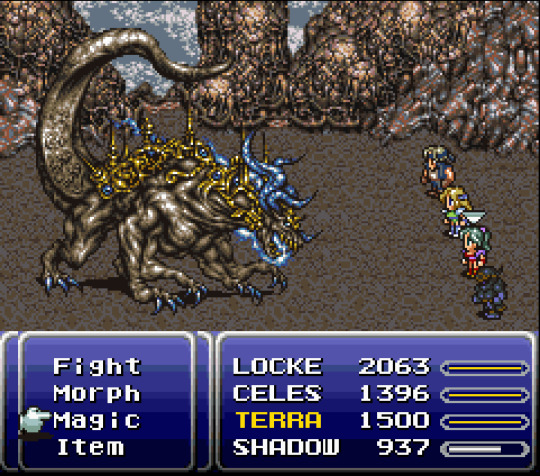
I find the style of the game unique for its time because you can easily split the game into two parts. There's a pivotal point in the story that changes everything. The first half is a typical story-driven RPG. The second half is actually more open world. With a huge cast of characters, you are not actually required to end the game with all of them. The second half of the game offers a unique style where you can take on the final boss with what you’ve got, or hunt down the rest of the cast members and then take on the final boss.
Graphics:
This is the SNES in its prime. Character sprites are much bigger, and the world looks so much more detailed and vibrant. Shadow looked weird though. Sometimes you had to squint to discern what his face actually looked like. Other than that, the game looks great! It’s notable for utilizing more graphics power from the SNES in some cutscenes, and also when you fly an airship.


The PlayStation One version again has a FMV sequence that hasn’t aged well at all. Okay, maybe it’s a tad bit better, but that’s not saying much.
Story:
One of the biggest debates in recent Final Fantasy fandom is asking whether Final Fantasy VI or Final Fantasy VII is better. While I won’t get into Final Fantasy VII much now, it was always the most popular game in the series. It seems that in recent years, gamers have retroactively judged Final Fantasy VI as the best Final Fantasy game of all time.
I wish I had appreciated more when I was a kid. When I first played it then, I actually despised it. I was much more critical about stories back then. For whatever reason, I didn't think the world building was coherent. I also wasn’t used to Final Fantasy games by then.
I finished Final Fantasy VI about four years ago, and that time I was taken by it. I became enlightened and completely changed my opinion of it from sour to sweet. I wish I could erase my memory on playing it only so that I could experience it for the first time and appreciate it for the first time. I had already known most about what happened in the story, so I really wish I could experience the shock and awe of it brand new. Final Fantasy VI does things with its story that no other Final Fantasy game has done. It has drama, it has brevity, it has an amazing cast of heroes and villains. To date, it has the most playable characters in a Final Fantasy game.
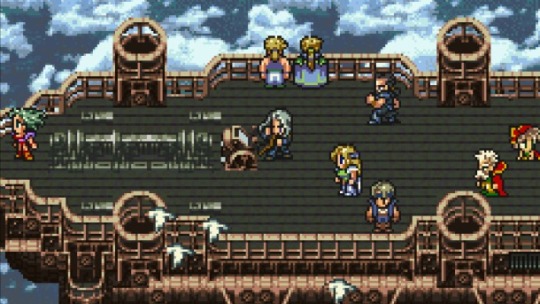
The plot even incorporates a little opera that you sit through.

At first glance, Final Fantasy VI seems derivative. There is once again an evil empire seeking to control the world, and there is once again a rebellion. People often make the parallel to Star Wars, much like Final Fantasy II. The name “Returners” doesn’t quite stick with me personally as the name of an epic rebellion. Final Fantasy VI also created the recurring characters Biggs and Wedge, a further nod to Star Wars.
But you have to look past the simple setup of a ragtag rebellion fighting an evil empire. First of all, the steampunk setting is one of the most original in a Final Fantasy game to date, and hasn’t really been revisited. The world dabbles in late 19th century architecture, with fine arts and opera. The empire is only beginning to realize the ancient power of magic, and combines it with technology to make “Magitek”, starting a sort of “industrial revolution”. The opening scene to this game is one of the most memorable. Terra, under the empire’s mind control device, in her magitek armor with Biggs and Wedge, trudging through the snow as the opening credits roll by, comes off as a real live-action movie.
While the official creators say that there isn’t a main character, I still say it’s Terra. If not, she’s at least the most important. She propels the plot forward. She’s one of those rare great female protagonists in a video game RPG. She’s more than just “a strong female character”. She has depth as she tries to find her place in the world, and other characters, such as the thief Locke, try to help her.
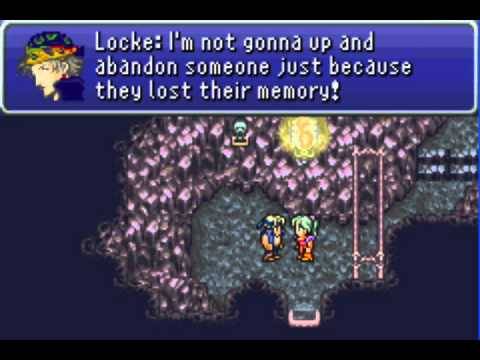
Also, just like Final Fantasy V, Final Fantasy VI has its own villainous goofball - Ultros.

He’s not quite as charming as Gilgamesh, but he acts in the same manner regardless.
Each character has their own story – no matter how small or big. They’ve all lost loved ones, or suffered hardships, and the central theme about the entire game is really about grief and dealing with it even in the face of nihilism.
Nihilism comes in the form of Kefka - Emperor Gestahl's court mage. Kefka did the whole nihilistic evil clown thing before Heath Ledger's Joker in The Dark Knight. Kefka retroactively rose to popularity, rivaling longtime favorite villain Sepiroth from Final Fantasy VII as the best Final Fantasy villain.

Final Fantasy VI deals with heavy topics. I was shocked that it even dared to show a scene of attempted suicide. Things get dark. Really dark. But Final Fantasy VI deals the darkness with such elegance. I admire its ability to treat such heavy plots for basically children.
The ending to this game is probably the most epic out of any Final Fantasy game. I can gush with details but this is meant to be a spoiler - free review. I just have to say – E P I C. But the most admirable thing I just have to say is that it treats Terra’s journey with the utmost respect and tact. It doesn’t try to define her by having some hokey romantic subplot.
Music:
Another legendary score. Given the tone and atmosphere of the story, the score reflects something darker. Right away, the opening titles before you begin is accompanied by foreboding music. With the exception of battle themes, the story demanded that Uematsu put away most of his drumming and rock undertones for a more conventional, instrumental score with pathos. It sounds most like the score to an actual fantasy movie, very operatic and Wagner-like.
Shadow’s theme sounds inspired by typical Western movie fare, being that he is a drifter. In fact, Final Fantasy VI’s score is diverse in tones with its character themes, which is obvious once you think about where all the characters come from. Cyan’s theme has Asian influences. The theme for the Veldt, a stretch of wilderness, has a jungle beat. Then of course there’s the opera music. Many Final Fantasy concerts, such as Distant Worlds, play the opera about the fictional characters Draco and Maria. Kekfa, the villain, has a jovial but sinister theme scattered throughout. Terra’s theme is practically the main theme of the game, and it too is referenced throughout.
The end credits song is a whopping 21 minutes and 36 seconds. It goes through every single character’s theme and more. The entire soundtrack is 3 hours long. I don’t think any other game at the time had a soundtrack that long.
Notable Theme:
“Dancing Mad”
To me, Dancing Mad is Nobuo Uematsu's magnum opus. It is a sprawling 8-minute epic for the final battle.
youtube
Verdict:
A must-play. Any RPG fan will love this game. Any RPG fan SHOULD play this game. There’s nothing obnoxious or vainglorious here. Every subsequent Final Fantasy game tried to live up to its drama and scope, but with all of them falling short ever so slightly.
Direct Sequel?
No. Thank God.
#final fantasy#final fantasy vi#final fantasy kefka#kefka#kefka palazzo#square enix#fantasy rpg#rpg#video games#video game rpg#onvideogames#terra branford#terra
33 notes
·
View notes
Text
Anime Update V2 33
Wolf’s Rain - The wolves and Cheza went through the cliche named Forest of Death, got lost for a while, followed the directions of an owl who spoke in rhyme and almost got eaten by killer insects until Cheza tricked them into getting eaten by killer plants. It was rather strange. But there was also interesting stuff with Lord Darcia and Cher on the side and I’m intrigued to see where that plotline goes.
Hunter x Hunter - Hold it! Hold the fuck on, 1999 anime! No. No! You do not get to end at this point in the story, before the Yorknew City arc has even finished! Making this the series finale is not only INSANELY anticlimactic and abrubt, making it one of the worst, most underwhelming endings I have ever seen, but there are a dozen of threads that are still left dangling, especially the whole deal with Gon’s dad and Greed Island! What was even the point of that build-up if we get zero payoff?!? And were we expected to actually think the entire Phantom Troupe got killed off-screen and be satisfied with that, only for Hisoka going “lol, we’re still here!” in the stinger to be some big twist reveal?! Come on! In any case, the 2011 anime thankfully still continues beyond this point all the way to a proper ending, so like Fruits Basket, I’m on just one adaptation from now on.
Fruits Basket - The episode where Tohru and Yuki go to Ayame’s clothes store, now done in this anime. Not much more I can say.
Rozen Maiden - How much I’m into this series after it begun on a truly rancid premiere episode continues to astonish me. Suigintou has now arrived in the parallel timeline, gets into another “flowers VS feathers” fight with Shinku until adult Jun tells them to SIT DOWN, and now Shinku and Suigintou are basically flatmates and good lord, I did not know how much I needed this set-up, it is hysterical. And speaking of Shinku, Luci Christian got much better at voicing her by this point - still prefer Mela Lee, but she’s a very close second. We also got the glorious return of Megu, and for the life of me I can’t understand why a lot of fans apparently hate her, she’s easily one of the most interesting characters in the whole series. Adult Jun also continues to be interesting in how he lives his life and handles this Rozen Maiden situation, and I’m getting a sinking feeling that the advice he’s getting from “kid Jun” isn’t leading him the right way....
Honestly, the best part of this series is that if you skip Episode 1 and then ignore some stuff like the Hinaichigo weirdness that ended this round, you could easily see it as the continuation of the original anime we never got, finally getting to tell Rozen Maiden in full.
Fate Zero - It was a meeting of kings for drink and discussion, totally appropriate for Thanksgiving, right!? Gilgamesh is still the worst and had nothing of value to contribute to the discussion, but while I do agree with Saber that a ruler needs to have solid principles and feel beholden to a committment to a set of ideals higher than any mortal person, I was on Rider’s side for pretty much everything else. He demonstrates in word and in deed that he’s clearly the greatest king among the Servants, that he knows what the weight of such a status means for the person who holds it and those who follow him, and what it takes to inspire undying loyalty from his subjects and soliders. If he wasn’t a conquering, warmongering tyrant, I’d follow him readily!
Revolutionary Girl Utena - As the time where Utena must finally bring the world revolution begins, the show needed to pile on more mind screw with how Utena and Anthy’s relationship takes a shift following her realizing that Anthy is a user in an incest relationship with her manipulative and subtly abusive big brother. The part with Anthy and Utena casually admitting to “poisoning each other” followed by the fantasy sequence of Utena trying to stop Anthy from jumping off a high ledge really spoke volumes about what is going on with both girls, individually and in their relationship with each other. Also, yay for getting to see Nanami again! Utena needed her now!
Senki Zesshou Symphogear - So now that Hibiki’s secret is out to Miku, they’re having the breakup from each other that I’d expected. There was also a brief detour with Chris helping these two kids find their father they got lost from, and I wish this had been carried for more of the episode, as it was nice and really good at humanizing Chris. But then Chris herself also goes through a breakup of sorts with her master, the Big Bad who is pretty much literally Lusamine. I’m not joking, her attitude and even her design are near identical!
AMC: Talentless Nana - Watched both the episode where Kyouya closes in on Nana’s latest string of murders and almost busts her in front of their classmates, and the one that introduces Jin Tachibana, the one character who can out-Magnificent Bastard Nana (and who’s voiced by Jonah Scott in an eerily uncanny mpression of Liam O’Brien!). And yes it’s still fun and all, but the show’s weaknesses are visible at full force at this point for whatever reason, and I think two things helped to pinpoint it; first, the deaths of Habu and Kaori. We got next to nothing of substance from those two characters despite their closeness to Michiru and having distinct designs and talents (especially Habu!), which just shows how most of the characters in this setting no matter how promising literally exist for the plot and to be offed whenever said plot and Nana and Kyouya’s character arcs needs them to be offed. Second, Jin’s entire shtick is that he’s a shapeshifter who can impersonate other characters and even use their talents. Which makes you think wow, what’s even the point of those others if this dude can do it all and probably better? Even Michiru, who I do like, is a wate of a character who they do just the barest minimum with, and I’m glad she wasn’t a surprise villain like Jin impersonating her made it seem but she does need something to make her more interesting beyond her basic tropes. Dogs can be petulant and vicious - let the dog girl be vicious! Basically, Nana and Kyouya remain the only characters with any deep meaning to them in the long run, while the rest are just a buffet of side villains or victims.
0 notes
Text
7 sci-fi writers who should pen new 'Star Trek' episodes
New Post has been published on https://writingguideto.com/must-see/7-sci-fi-writers-who-should-pen-new-star-trek-episodes/
7 sci-fi writers who should pen new 'Star Trek' episodes
AsStar Trekfans react to the announcement of anew TV series for the franchise, we’re seizing the opportunity to imagine which acclaimed sci-fi writers we want in the captain’s chair.
One of our favorite things aboutStar Trek, in particular the original series (TOS), is itsdirect connection to the culture of science fiction. Richard Matheson, Theodore Sturgeon, Harlen Ellison, Peter S. Beaglethese are just a few of the many acclaimed writers of science fiction who wrote iconic episodes for TOSand its successors over the years. Not only did TOS consistently put established and important sci-fi writers at the helm of the Enterprise, but Next Generationspringboarded the careers of a bevy of writers who went on to create over a decade of sci-fi shows on television.
So who’s next? CBS has a huge opportunity here to return to the show’s roots and invite a modern generation of sci-fi writers, both young and old, to leave their mark on the series that helped shape many of them into the writers they are today.
Here’s our wish list of writers we’d love to work onStar Trek for a new agehopefully inspiring a generation of new writers in their stead.
1) Connie Willis
Goodreads
Who better to write for the most beloved science fiction franchise than the writer who’s won more awards than any other science fiction writer in history? With her epic Doomsdayseries as well as other standalone novels, Willis seamlessly merges high themes like religion and death into intricate concepts like time travel and journeys inside the mind. She’s also an expert on the genre and how to thoroughly canvass it for new ideas, which is probably why we can’t stop giving her all the Hugos and Nebulas. We can’t think of anyone better qualified to usher TV’s most iconic space opera into its new era.
2) Andy Weir
Goodreads
Come on, the guy just put a man on Mars. Nothing is more Trekkie than that. The Star Trekfandom isalready cracking jokes about Weir’sMartianMark Watney being a member of Star Fleet. This needs to happen.
3) John Scalzi
Goodreads
This one’s a no-brainer: Of course CBS should tap Scalzi, with his massive blog audience, social media reach, and string of acclaimed bestsellers including an actual work ofStar Trekfanfiction, to write new episodes ofStar Trek. InScalzi’sRedshirts, the expendable, nameless crewmen of the Enterpriseactually nicknamed “redshirts” by the fandom because of their red uniforms indicating low rank on boardtake control of their fates to halt their high death toll. How much would welove to see Scalzi turn this idea into actualStar Trekcanon? Make it happen, guys.
4) N.K. Jemisin
Goodreads
Though Jemisin is known for her award-winning works of fantasy, she started out writing science fiction before transitioning into fantasy and has statedthat “science fiction and fantasy are pretty much equal partners to me.” Her books are brimming with realistic worldbuilding and real physical and social sciences, like her most recent dystopian repeat apocalypse-ridden Fifth Season.Her take on her genre harkens back to classic forms of fantasy likeGilgameshandThe Iliadrather than Tolkien and his descendantsall things that make her an ideal writer to put her own unique spin on the mythology of Star Trek. She’s also been outspoken on the shortcomings of Star Trek’s recent iterations regarding race and other forms of representation. As a writer who constantly looks father afield for tropes and influences than Euro-centric fantasy, Jemisin isthe kind of writer the new millennium Star Trekneeds.
5) Cory Doctorow
Goodreads
Few sci-fi writers have been so closely concerned with the real-life issues that spawn the dark visions of cyberpunk dystopias as Doctorow, who made a name for himself championing Internet freedom, open source and remix culture, and Creative Commons alongside his contemporary sci-fi novels. A true futuristic visionary, Doctorow has the talent to churn out mind-bending installments of new Trekaimed at future cyber-rebels like himself.
6) Peter David
Goodreads
The illustrious David has a long and formidable career of sci-fi, comics, and fantasy writing to his name, and he’s not even out of his 50s. Moreover, he’s got tons of experience writing for Star Trek:io9 called him “the undisputed master ofStar Treknovels” thanks to his string of tie-ins for the franchise in the ’90s, including The Riftand Izmadi, both considered must-reads by the fandom. He also has another distinction that makes him perfect for the new era of Star Trek: finally turning the long-subtextual friendship of Rictor and Shatterstar into a canonical gay relationship in his acclaimed run of X-Men. We’d love to see David getting his hands on newStar Trekcharacters and applying his new, fresh ideas to a series he’s familiar with of old.
7) Junot Diaz
Goodreads
This Pulitzer-winning MacArthur fellow is best known for The Brief and Wondrous Life of Oscar Wao, a pseudo-autobiographical literary work tinged with magical realism about a science fiction and fantasy fanboy. Diaz has always had a complex relationship with science fiction, and a keen awareness of the ways in which the genre both confronts and is limited by post-colonial power dynamics. After just missing out on a couple of epic science fiction novels from Diaz, we would rejoice if he finally got to flex his sci-fi muscles in an episode ofStar Trek.
Honorable mentionsa few sci-fi heroes we’d love to see try their hand at Trek, though even we have to admit the odds are pretty unlikely: Margaret Atwood, Samuel Delaney, Karen Joy Fowler, Neil Gaiman, Kelly Sue DeConnick, and Dan Harmon.
Who’s on your ultimate Star Trekwishlist?
Photo via Kanjioman/Flickr (CC BY 2.0)
Popular on The Daily Dot
How DJ Akademiks became hip-hop's one-man TMZ
Content mill DJ Akademiks is changing urban newsone watermark at a time.
By Clyde Lovellette — November 03, 2015
Read more: http://www.dailydot.com/
0 notes
Text
Final Dream Brave Exvius Wiki.
Welcome to Shinra News (formerly Existing Events, Midgar Press and Bonga Bugle), the propaganda machine of the Shinra Electric Power Company, now hosted at the Final Dream Wiki. 17 In extension, among the primary themes of Last Fantasy XV is brotherhood, which can be viewed as juxtaposition to the theme of sisterhood in Last Fantasy XIII (Lightning and Serah, as well as Fang and Vanille ). Last Final Fantasy XV a New Empire Guide Fantasy VII has actually been inducted into the Strong National Museum of Play's World Video Game Hall of Popularity. When transitioning to the next generation of computer game consoles, the now-merged Square Enix developed Last Dream XIII for PlayStation 3 and Xbox 360 It was developed utilizing Crystal Tools, an exclusive engine developed to develop video games for the consoles. Final Fantasy XV was originally titled" Final Dream Versus XIII" The video game was directed by Tetsuya Nomura, part of the Fabula Nova Crystallis: Final Dream series, and planned to be playable on the PlayStation 3 When Last Dream Versus XIII was rebranded, its advancement Final Fantasy XV a New Empire Hack group was reorganized. It's a rejuvenating modification to the Last Dream series that fans are exceptionally excited about. Recent controversy sprung up after one popular, partnered Discord server dedicated to Final Fantasy XIV was released a warning for an NSFW channel and lost its partner status as a result. Despite this, Last Dream 7 Remake director Tetsuya Nomura has actually attempted Final Fantasy XV a New Empire Guide to reassure fans about the progress the development team are making. Southern brooke sex video is a single person 52 Aramusha in it. In theatrical the game, a fossil variety of assembly models, opponents, and doing styles from Last Prove X were recycled. Final Fantasy VII isn't going to be a single video game sliced up into pieces: it's going to be a series of complete stand-alone video games that, together, retell Final Fantasy VII's legendary plot. Before that, Nomura was tied up for many final fantasy xv a new empire cheats years with the long-awaited Final Dream XIII spin-off Final Dream Versus XIII, which Square Enix announced in E3 2006, the very same location where the PlayStation 3's $600 cost and the Nintendo Wii made their big launchings. Characters from numerous Final Fantasy video games have made appearances in video games like Kingdom Hearts, Ehrgeiz, and Dissidia Numerous particular main series games have likewise gotten direct sequels or spin-offs which often inhabit various categories. Initially referred Final Fantasy XV a New Empire Hack to as Final Fantasy Type-0 Online, Final Fantasy Awakening is a successor to the defunct mobile video game Final Fantasy Agito, taking place in deep space of Orience from Last Dream Type-0 While an English-language release has been confirmed, releases in the West and Japan remain unofficial. Square Enix has actually shocked the western audience today by revealing that Dissidia Final Dream Opera Omnia, will not be unique to Japanese iOS and Android mobile phones by the end of this month. Note that this guide covers the mainline Last Dream games Final Fantasy XV a New Empire guide just, and it's focused around the single-player games. Their design, visuals, and music have affected the video gaming market throughout the years and there is no doubt of Last Dream's innovation worldwide of RPGs. This consists of the general design of protagonist Cloud Strife, whose appearance has supposedly been altered to be more in-line with his original appearance in the PSOne variation of Final Fantasy VII. Indeed, most final fantasy xv a new empire guide fans believe that the whole of the Last Dream series does not, in fact, occur in the very same universe. Years after that huge E3 expose, we still do not know when the Final Fantasy VII remake will hit consoles. The producers of the live orchestra efficiency phenomenon Far-off Worlds: music from LAST FANTASY are happy to reveal an intimate FINAL FANTASY music experience. Final Fantasy IX was a "return to form" for the series, going back to series roots, taking Final Fantasy XV a New Empire Hack place in a medieval inspired world, bringing back the more classic tasks and character styles along with a lot more aspects of the Nintendo era Final Dream video games. The American Express logo design, as it appears on a window in Final Fantasy XV. In Final Fantasy VII, magic is a product of the Lifestream and can be used by means of Materia, though scientists have actually specified that "magic" is an unfitting term for a force of nature. final fantasy xv cheats remake is various. Yoshida fixed to obtain Last Dream XIV in a much better state before even thinking about combining forces. This item is not suitable with the Steam version of LAST FANTASY XIV: A Realm Reborn. Clash On The Big Bridge (likewise known as Battle With Gilgamesh) is a signature tune from Last Dream V commonly utilized in important remixes and MADs The tune Final Fantasy XV a New Empire hack is likewise known as the theme of Gilgamesh, a recurring villain in the series. LAST DREAM XV is the extremely prepared for next installment in the legendary series that specified storytelling and experience in video games.
0 notes
Text
New Post has been published on Mythology.net
New Post has been published on http://mythology.net/mythical-creatures/dragon/
Dragon
What is a Dragon?
It depends on who you ask! These world-famous creatures come in all different shapes, sizes, and dispositions. From small symbols of luck to giant, fire-breathing foes, Dragons are full of surprises.
Characteristics
Physical Description
If Dragons existed, they would probably be a genus rather than a species. Several, distinct types of Dragon are scattered across the globe.
Chinese Dragons (also popular in Japan and Korea), have long, snake-like bodies and four short legs. Their long necks support large, doggish heads with fluttering manes, whiskers that look like dangerous whips, and sometimes antlers! Their backs are covered in scales, and their bellies are plated in hard armor. A ridge of spikes runs down their spine. Their bodies are usually bright red or green, but their faces are an eruption of many vibrant colors.
European Dragons (also called wyrms) are reptilian, like their Chinese cousins, but instead of resembling snakes with oversized heads, they resemble lizards, with compact bodies, powerful legs, long tails, long necks, and small, horned heads. Their colors are somber, usually dark shades of red, blue, or green. The crowning-glory of the European Dragon is its wings, which can stretch out to great widths and cast a terrifying shadow when it is soaring above.
Finally, sea serpents can be classified as a type of Dragon. These watery creatures are like a cross between their Chinese and European cousins, having long, wingless bodies with somber colors, and small heads. Since they live in the water, they don’t have legs, and they may or may not have flippers. Sea serpents are the largest of all the Dragons. Some of them are so enormous that it is impossible to see from their head to their tail!
Personality
The Latin root of the word Dragon is drak, which means “watch closely” or “see clearly.” The tag holds true. Whatever else Dragons might be, they are always alert and on the lookout.
Chinese Dragons are symbols of luck and majesty. They watch over the worthy people of Earth, helping emperors protect their thrones and scaring demons away from villages. Although they are powerful—and they certainly enjoy basking in praise—they are rarely aggressive towards humans.
European Dragons, on the other hand, are highly aggressive and dangerous! Instead of guarding over villages, they pillage them, carry off their maidens and their treasure, and jealously protect it from any challengers. Their greed knows no boundaries, and they will defend their treasure trove to the death.
Of all the dragons, sea serpents are the least likely to seek out an encounter with humans. They lurk in the dark chasms of the ocean, and unless they are disturbed, they simply ignore human civilization. Still, a passing ship can provoke a serpent—and they are not friendly when their territory is invaded!
Special Abilities
The Dragons’ abilities are well-aligned with their personalities.
Chinese Dragons use their magical powers to shower blessings upon villages and dynasties. They are particularly associated with water, and they can be called upon to bring relief during a drought. They are often sought for their wisdom as well; those who can speak to humans deliver shrewd advice and even prophecies. At the very least, they can bring good luck to their favorite household.
The warlike European Dragon has much more ferocious talents. Their wings may look like bat wings, but they are as strong and agile as a hawk, allowing the beasts to fly for great distances, then dive towards the earth at a breakneck speed. They breathe fire; their bite is poisonous; and their blood is corrosive. Some European Dragons seem to act on sheer animal instinct, but others are cunning, and when they choose to speak to humans, they can weave hypnotic riddles.
Sea serpents, the most mysterious of Dragons, have variable talents. Some are capable of breathing fire, which makes the water around them boil, and others can whip up whirlpools or tidal waves.
Cultural Representation
History
Dragons appear in our earliest attempts at literature, including The Epic of Gilgamesh, The Iliad, Beowulf, and the Rigveda. What’s more, the archaeological record suggests that Dragon-lore is even older than written language.
It’s easy to prove that Dragons are an ancient race, but pinning down the origin of their legend is trickier. These mighty creatures pop up at the dawn of cultures all over the world. Even isolated cultures, like the Aborigine people in Australia, can lay claim to their own special breed, making it impossible for any single culture to claim that they invented the myth.
Still, some cultures have influenced the evolution of Dragons in other cultures. For example, the emergence of Christianity had a huge impact on Greco-Roman, then European, Dragons. The original Greco-Roman monsters were serpents, often without legs and with multiple heads. They were wild and powerful creatures, but they weren’t evil. Christianity turned them into the jealous, fire-breathing monsters that we think of today by associating them with Satan and Hell. Christianity also gave rise to the classic dragon-hunting hero by claiming that important saints had defeated Dragons (symbols of Satan).
Modern Appearances
Today, European Dragons continue their reign as the ultimate fairy tale villain. They have appeared in major fantasy franchises, like JRR Tolkein’s Hobbit, JK Rowling’s Harry Potter, and DB Weiss’s Game of Thrones, and they have even inspired some series all to their own, like Christopher Paolini’s Inheritance Cycle.
Video and role-playing games have capitalized on the European Dragon’s ferocious reputation by giving players a chance to face off with the legendary beasts. They appear, of course, in Dungeons and Dragons, as well as Final Fantasy, Mario, Pokemon, Zelda, and Mortal Combat.
Meanwhile, Chinese Dragons remain popular in Asian art, especially pottery and paper mache. Crowds of people don Dragon costumes and carry Dragon banners around the turn of the New Year, in order to secure good luck for the days to come.
Explanation
Despite the presence of Dragon stories all over the world, science hasn’t produced a single scrap of evidence that these massive beasts are real. Still, reality has its own monsters, and some of them may be responsible for firing up our imagination.
Dinosaurs are the closest thing the world has seen to Dragons. Indeed, some dinosaurs could rival dragons in their size and ferocity. A flying pterodactyl could probably wage a terrifying air battle with a Dragon, while a tylosaurus might have been able to bite a sea serpent in half! Of course, dinosaurs died out roughly 60 million years before humans emerged, but an ancient person who stumbled upon their bones might not know that!
Crocodiles are another prime candidate for the impetus of Dragon-lore. Various species of crocodile are scattered across the globe. In Africa and southern Europe, the fearsome Nile Crocodile can grow up to 16 feet long and weigh up to 2,400 pounds. Saltwater crocodiles, which are found in India, Indonesia, the Phillipines, and Australia, can be even larger: up to 23 feet and 2,600 pounds. They might not pillage villages or horde treasure, but these deadly predators can easily claim a human life.
Large pythons and monitor lizards also have the potential to be mistaken for Dragons.
Alternatively, some researchers have theorized that Dragons spring from human instinct itself. They might be a conglomerate of proto-human predators: large mammals with claws and teeth, snakes with scales and poison, and eagles with vast wings.
1 note
·
View note
Text
New Post has been published on Otaku Dome | The Latest News In Anime, Manga, Gaming, And More
New Post has been published on http://otakudome.com/square-celebrating-30th-final-fantasy-anniversary/
Square Celebrating 30th Final Fantasy Anniversary
Square has a big celebration planned for Final Fantasy’s 30th Anniversary:
LOS ANGELES (Jan. 31, 2017) – At today’s official FINAL FANTASY® 30th Anniversary Opening Ceremony in Tokyo, SQUARE ENIX® commenced a year-long celebration for the franchise’s 30-year legacy, revealing new details, art and videos surrounding some of the franchise’s most anticipated games, including FINAL FANTASY VII REMAKE™, FINAL FANTASY XV, and FINAL FANTASY XII THE ZODIAC AGE™.
Square Enix also unveiled the official FINAL FANTASY 30th Anniversary logo and website (www.finalfantasy30.com) where fans can use the hashtag #FF30th to share their favorite experiences and stay up to date on the various events planned for the rest of the year.
During the opening ceremony, announcements were made by special guests including Shinji Hashimoto, Square Enix Executive Officer, FINAL FANTASY Brand Manager. Hashimoto presented several announcements surrounding new and upcoming content including:
FINAL FANTASY VII REMAKE Brand-new key art for the highly anticipated FINAL FANTASY VII REMAKE was unveiled, depicting the game’s protagonist and mercenary Cloud and his iconic Buster Sword set to the background of Midgar, base of the Shinra™ Electric Power Company.
FINAL FANTASY XII THE ZODIAC AGE North American players can look forward to returning to the world of Ivalice in FINAL FANTASY XII THE ZODIAC AGE on July 11, 2017 for the Playstation®4 computer entertainment system. The visual and audio remaster of series classic FINAL FANTASY XII will feature a job character progression system for the first time in the West. New key art from famed character designer and artist Akihiko Yoshida was also revealed, featuring the main cast of the game including Ashe, Balthier, Fran and Vaan.
FINAL FANTASY XV: Episode Gladio DLC The first sneak peek at some of the upcoming DLC for FINAL FANTASY XV was showcased on-stage, highlighting the brand-new perspective players will experience in the coming months. The FINAL FANTASY XV Booster Pack (Free Version) and FINAL FANTASY XV Booster Pack + are scheduled for release on February 21, and will be available for all players or Season Pass holders, respectively. The DLC content will include powerful items such as the invincible outfit, “Magitek Exosuit” that give players an advantage during battles.
FINAL FANTASY XV Episode Gladiolus releases on March 28, and will be available to players who purchased the Premium Edition or Season Pass and can also be purchased separately via the Xbox Marketplace or the PlayStation®Store. Through this DLC, players can enjoy an episode depicted from Gladio’s perspective. Gilgamesh, one of the franchise’s fan-favorite characters will also be making an appearance in the episode.
FINAL FANTASY BRAVE EXVIUS FINAL FANTASY BRAVE EXVIUS®, the full-scale FINAL FANTASY adventure for mobile devices that has achieved over 20 million downloads worldwide, recently began an in-game collaboration event with internationally renowned artist and actress Ariana Grande. All players will be able to acquire “Dangerous Ariana,” the Ariana Grande-inspired character exclusively designed for the game until February 2 by completing the first stage of the special in-game event, “Dangerous Woman Tour.”
MOBIUS FINAL FANTASY MOBIUS FINAL FANTASY™, the critically acclaimed mobile RPG adventure will be making its way to STEAM® next month on February 6. The title offers an all-new RPG adventure featuring a deep story, stunning visuals, in-depth character customization and a refined turn-based RPG battle system. To celebrate over 10 million registered users worldwide and the 20th anniversary of FINAL FANTASY VII, various in-game bonuses and a special FINAL FANTASY VII REMAKE collaboration event will begin on February 7 for a limited time.
0 notes